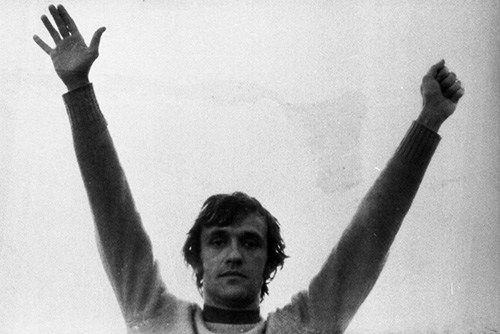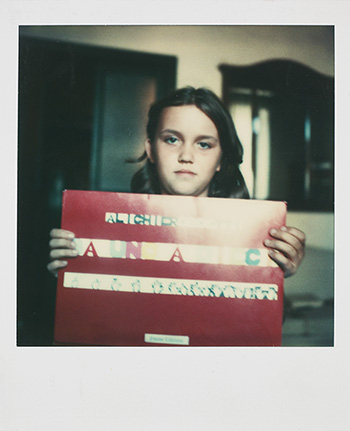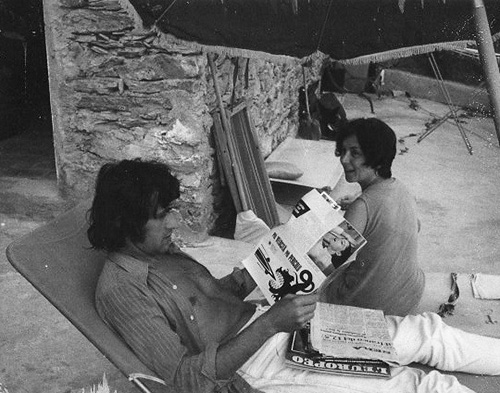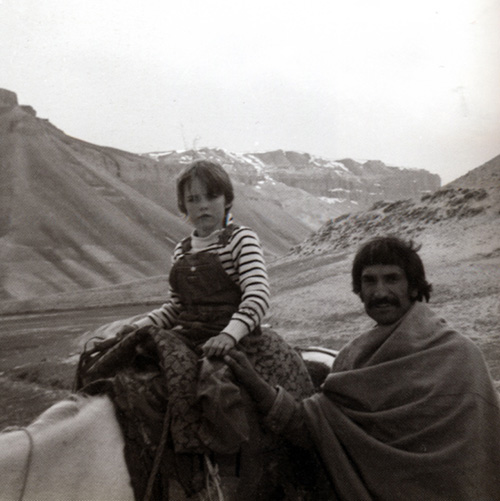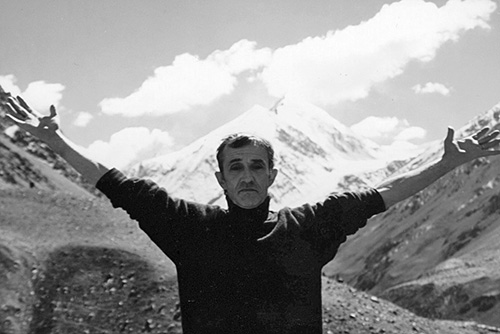CHRONOLOGICAL BIOGRAPHY
Chronological biography written by Annemarie Sauzeau for the General Catalog
1940
Alighiero Fabrizio Boetti was born on 16 December, at 5 Corso Trento in the Crocetta district of Turin.
He came of an aristocratic family originally from Fossano (Cuneo). The Counts Boetti had lost their landed estates in the nineteenth century and the following generations practiced the legal profession in the city.
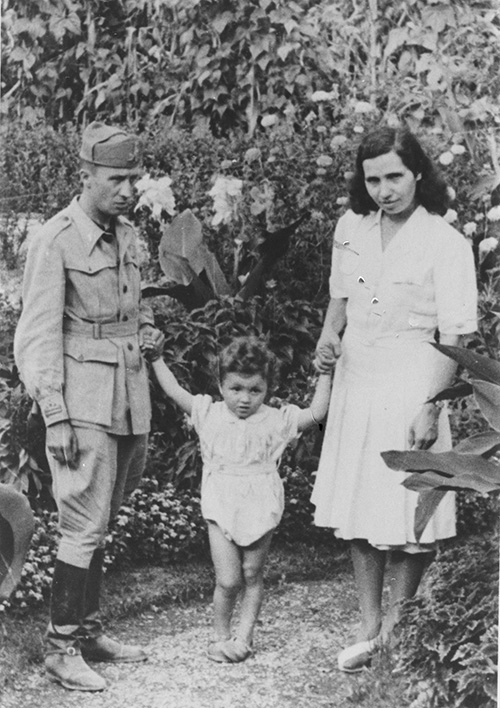
Alighiero Boetti with his parents, 1942-1943
His father, Corrado, was a lawyer. His mother, Adelina Marchisio, had been a promising violinist but devoted herself to domestic life, while his sister Elena had a significant career as a pianist and teacher at the City Conservatory of Music. With his elder brother Gualtiero, Alighiero passed an unhappy early childhood, having been evacuated with their mother to Giaveno in the countryside until the war’s end, while their father was at the front.
His adolescence in the postwar years was even more difficult. His parents separated in 1949 and he grew apart from his father, who offered him very little emotional or practical support. Alighiero attended Michele Coppino Primary School, the Germano Sommeiller Technical School. He then enrolled very unwillingly in Business School but soon dropped out.
1955-1961
Boetti is an autodidact. Pavese, Montale, Mann, Faulkner and above all Herman Hesse (whose complete works he read) were some of the authors who meant most to him.
Turin at the time was a highly stimulating city with an international outlook, largely due to the Einaudi publishing house and certain other outstanding points of cultural focus, such as the Galleria Galatea run by Mario Tazzoli. Here the young Boetti discovered Tantric art. His initiation into contemporary art came at seventeen in Luciano Pistoi’s Galleria Notizie, where he saw watercolors by Wols, works by Fontana, paintings by Gorky and Rothko, drawings by Henry Michaux and discovered Cy Twombly in 1963 (a year also notable for Balla’s first major retrospective at the Galleria Civica).
In around 1960 AB painted a number of works in Art Informel style using oil or tempera on canvas or cardboard. “At twentytwo he did not yet see himself as a painter, but his vocation as an artist was not in doubt. His masters were Matisse, the Balla of the abstract exercises and watercolors, Wols and Nicolas De Stael, who he regarded as the Cesare Pavese of painting. But he believed the greatest was Paul Klee.”
“I actually first became interested in the exotic when I was fifteen, thanks to Paul Klee’s Moroccan watercolors. He was born on 16 December like me,and this made my adolescent identification easier. Very ingenuously, I had ‘copied’ those watercolors before I knew who they were by.”
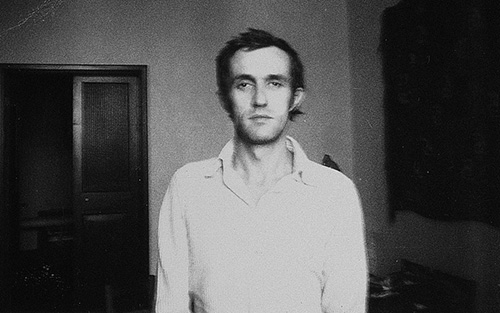
Alighiero Boetti in Turin, 1960. Courtesy Agata Boetti
At the same time, to make a living he set up a business and ran it for some years. He had got to know Provence through Delfina Provenzali, a translator and friend of the poet André du Bouchet (Nicolas de Stael’s son-in-law). In the village of Vallauris he bought ceramics by Picasso and other artists and sold them in Italy. It was here that in 1962 he met Annemarie Sauzeau, a young English teacher, who became his wife in 1964; they remained married until 1987.
1962-1964
Boetti moved to Paris in autumn 1962 and stayed there for most of the next two years. He saw at first hand the abstract lyrical works of De Stael, the tactile works of Dubuffet and Fautrier, and calligraphic Zen painting from Japan in a historical exhibition at the museum of the Petit Palais. He discovered the concept of André Malraux’s multicultural “imaginary museum” through the famous book published by Skira (reprinted many times from 1947 on). He absorbed it to the point where he confused it with the later exhibition organized in 1973 at the Maeght Foundation on the same subject.
“There was also that exhibition organized by Malraux in Paris in the early sixties: the ‘Imaginary Museum’ or something of the sort… He had chosen the finest pieces from different museums all over the world, Sumerian art, Egyptian, Khmer sculpture… I clearly remember an Assyrian statue in white marble with eyes in lapis lazuli.”
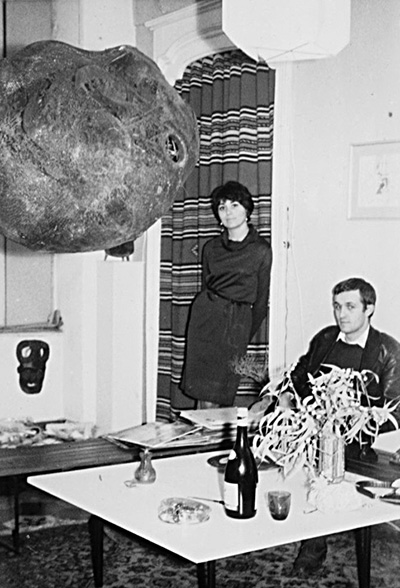
Alighiero Boetti and Annemarie Sauzeau, 1964
Lacking a studio, he concentrated on “chamber works”: drawings in India ink on kleenex and “combustions” of small boxes of matches, perhaps with an allusion to the Peintures-feu of Yves Klein, who had recently died in Paris (May 1962). In early ’63 he learned the technique of engraving in Johnny Friedlaender’s studio. Starting by using black ink he eventually developed a sophisticated polychromy. In the studio he also met the Cuban artist Ramon Alejandro, with whom he formed a close and lasting friendship. He read Marcel Granet and discovered the ideas of Gaston Bachelard. Piero Manzoni died aged thirty in Milan.
By autumn ’64 he had returned permanently to his apartment-studio on Via Principe Amedeo in Turin.
He still continued to do engravings, but his main focus was on large drawings in pencil on cardboard.
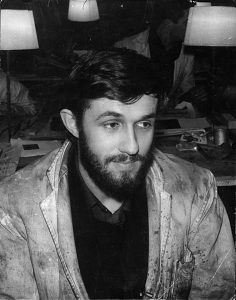
Alighiero Boetti at the Friedlander studio in Paris, 1963, photo by Annemarie Sauzeau Boetti
These works were subtly modulated from black to grey, as if they were engravings done with variable concentrations of ink. Unlike the early Parisian examples (non-figurative organic forms), he was now producing cold mechanical outlines traced using old Fiat engine gaskets or vaguely Pop comic strip imagery, with inscriptions similar to labels.
He also produced threedimensional objects, starting from scavenged pieces of sheet metal. He welded and spray painted them, leaving a “viewfinder” that traversed the chunks of metal.
“Among these objects suspended from the ceiling at the height of the eyes like a viewfinder, I can remember a piece of the bodywork of a van, with the side view mirror and the seat repainted a golden yellow.
1965
AB moved on to a new kind of drawing in India ink, doing black Chinese shadows and silhouettes: simplified outlines of combs, tumblers and bottles, industrial equipment, desk lamps, microphones, still and movie cameras. Boetti exhibited these drawings for the first time in 1981 in Paris and ten years later at his retrospective in Bonn.
“With microphones, lamps and viewfinders, still cameras and movie cameras, I wanted to create situations that engaged the viewer in a new dimension. Of the theater, in short.”

In the summer he began working in a small studio, a former porter’s lodge close to his apartment in Via Montevecchio where he had moved. These first non- pictorial works turned on the energy of “things,” which broke through the mural plane. Subsequently they were destroyed by the artist himself and only some sketches of them remain.
In conversation with Mirella Bandini in 1972, he said:
“The first was a masonite panel from which emerged a fist, a cast of my own, while I was on the other side of the wall. The idea was the energy of a wall opening out… Then I did other panels, a hand offering a chair; the chair was cut in half, with one part entering the painting.”
1966
On the art scene in Turin, AB tended to keep to himself. He produced numerous minimalist works. Some, in particular those using light installations which shortly preceded Ping Pong and Lampada annuale, were only exhibited between 2002 and 2003. Others, chosen by the dealer Christian Stein, formed the core of his first solo exhibition in January ’67.
“In the winter of ’65–66 I prepared an immense number of works and projects. By about May ’66, convinced it was impossible to use everyday practical objects, I tackled some new abstract works. They were lines on the ground, two flashing lights, a plexiglas panel suspended from the ceiling, some daises, sloping floors and even a well! There was still something of the theater in my need to put people in situations, even to amuse them.”
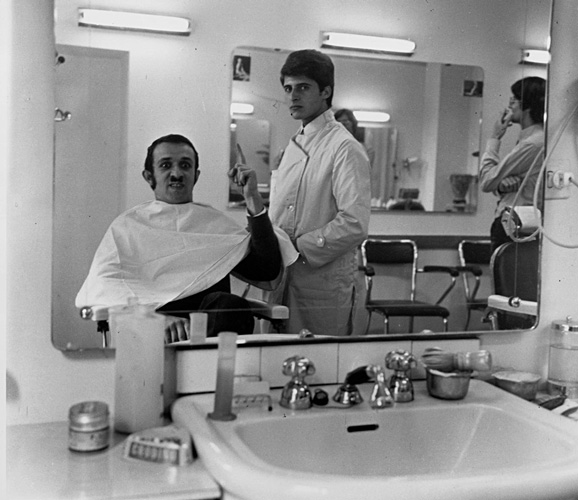
Alighiero Boetti with Giulio Paolini from the barber, photo by Anna Piva Paolini
This year AB began to frequent the avantgarde galleries run by Gian Enzo Sperone and Christian Stein, where he met some young Turin-based artists, including Mondino, Gilardi, Piacentino, Paolini and Pistoletto.
“I was on good terms with Pistoletto and saw Gilardi and Piacentino every so often, but we moved in different circles. Today, looking at things from a distance, I’d say everything came from that group. And Pascali, when he did the exhibition with the Cannons in ’66 at the Sperone Gallery, it was in Turin that he was most appreciated, and the same is true of Fabro.”
With Giulio Paolini, however, Boetti immediately formed a close relationship. Paolini himself recalled it in these words: “Alighiero and I met in ’66. There was immediately a special relationship, different from that between colleagues which I had with other artists from Turin. With him there was a friendlier and more confidential feeling, more open.”
1967
19 January, Galleria Christian Stein: opening of Boetti’s first solo exhibition. All the works exhibited dated from the previous year: for example, Rotolo di cartone ondulato, corrugated cardboard in the form of a ziggurat, Lampada annuale, which lit up once a year for eleven unpredictable seconds, Scala, Catasta, Sedia, Tubi PVC, Mimetico, Zig Zag and the diptych Ping Pong.
“Knowing of innumerable events that happen without our participation and knowledge, because of the pure impossibility of space and time, I was prompted to make the Lampada annuale as a theoretical-abstract expression of one of the infinite possible events, the expression not of the event but of the idea of the event… While the Lampada annuale was a totally literary work, of Catasta, Tubi or Cartone ondulato, all I have to say is: it’s a stack, it’s a roll of cardboard pushed up from inside, it’s a bundle of tubes and so forth.”
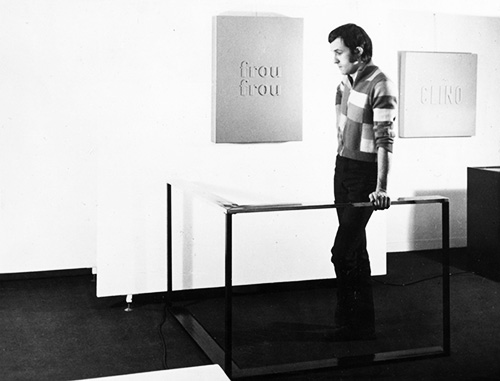
Alighiero Boetti at the Christian Stein gallery in Turin, photo by Paolo Bressano
In the profusion of ideas, gestures and objects of ’66, there was already an obsession with writing and two dimensions, with various panels devoted to language: stiff upper lip, the thin thumb, CLINO, frou frou.
“Sculpture or the object never interested me.”
All the more so in ’67 Manifesto was totally conceptual, and even the multiple Contatore. This first solo exhibition was reviewed by Tommaso Trini in two articles, in Domus (February) and Bit (March). Paolo Fossati reviewed the exhibition twice, in the journal Flash and the newspaper L’Unità.
In the spring following the exhibition, Boetti began what he called “panels of colors.” The raised wording, with a tautological effect, gave the name of the industrial color that had been sprayed across the surface as if it was a car body.
“In the case of Beige Sahara and seven or eight other colors, I wrote ‘Beige Sahara’ and used the color Beige Sahara.”
In this period he moved into a new studio, larger and brighter, on Corso Principe Oddone. Between the first exhibition at the Galleria Stein and his second solo show at La Bertesca in Genoa in December, he took part in all the early group exhibitions of Arte Povera in Turin, Milan and Genoa, especially “Con/temp/l’azione” curated by Daniela Palazzoli and held in the three Turin galleries Il Punto, Sperone and Stein, and “Le parole, le cose – Fluxus: Arte totale” held at the Galleria Il Punto and the Teatro Stabile.
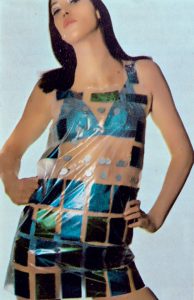
Dress designed by Alighiero and Annemarie Boetti, at the Pipier club, Turin, courtesy of Annemarie Sauzeau
In April Rotolo di cartone ondulato was added to the Museo Sperimentale d’Arte Contemporanea at the Galleria d’Arte Civica in Turin. Among the texts in the catalog, the essay “Situazione 67” by Germano Celant analyzed Boetti’s work in these terms: “The new monumental forms, instead of being made of natural materials—marble, granite or other types of rock—are made from artificial materials, steel, formica, plastic, plexiglas… Definitely more impressive and “present” are Boetti’s piles of tubes in masonite and in plastic, tactile aggregates of objects, on which the mere act of accumulation confers an independent and essential value, a sort of aesthetic register of elements in the pure state, a rejection of the problem of form.”
On 16 May, AB took part, with Annemarie Sauzeau, Piero Gilardi and Elio Colombotto-Rosso, in a “Beat Fashion Parade” held at the Piper Club in Turin, designed and organized by the architect Piero Derossi.
The “collection” by Boetti consisted in clothes made from transparent colored plastic containing heterogeneous materials.
In June he began a work in progress, Formazione di forme. The first “form” was that of the territories occupied by Israel extending as far as Egyptian Sinai, which AB traced from the newspaper La Stampa of that date. This and the following geographic forms, recorded on paper, always dated and taken from the newspaper, were incised in ’71 on twelve copper plates with the title Dodici forme dal 10 giugno 1967.
In July he took part in the group exhibition “Confronti” at the Galleria Christian Stein. On display were works by Fontana, Klein, Manzoni, Fabro, Kounellis, Lo Savio, Merz, Mondino, Paolini, Schifano and Twombly. In the summer he spent a long period in the Cinque Terre: at his home perched above the sea in the village of San Bernardino between Vernazza and Corniglia, he experimented with the possibilities offered by polaroid shots of his own body, taking self-portraits in Gran bacino and entrusting the shot of San Bernardino to his friend the fashion photographer Robert Cagnoli.
27 September–20 October, Galleria La Bertesca in Genoa: group exhibition “Arte povera-Im spazio” curated by G. Celant. AB was present in the Arte Povera section with a new Catasta, made up of twelve pieces instead of the previous thirty-four. This was the actual occasion when the Celant coined the Grotowskian concept of “poor art.” Of Boetti he wrote: “… The mode of definition is reduced to the mode of acting and being. Hence Boetti’s gestures are no longer an accumulation, a montage, wooden joint and stack… So here we have ‘figures’: the Castata as accumulation, the joint as joint, the cut as cut, the stack as stack, mathematical equations of real = real, action = action.” Subsequently, in the article “Arte Povera, appunti per una guerriglia” in Flash Art, Celant returned to the subject and described Boetti as an artist who “reinvents the inventions of man.”
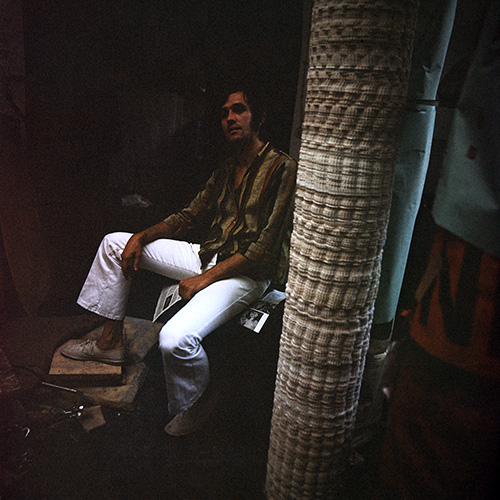
Alighiero Boetti in his studio in Turin, via Principe Oddone, photo by Mario Ponsetti, 1967
In December he had a solo exhibition at the same Galleria La Bertesca in Genoa, with new works, among which different versions of Mimetico and three-dimensional works, all reproduced in the catalog, the
first important publication to deal with AB. It contained farsighted essays by G. Celant, H. Martin and T. Trini. Thirty copies of the catalog were signed, numbered and accompanied by a drawing by the artist.
Other copies had four (six?) silk-screen prints in fifty copies: they were a posteriori industrial plans not only for the works exhibited but also other works like Rotolo (1966) and Catasta (1967). The prints were made by the Genoese art printer Rinaldo Rossi and marked the start of his continuing collaboration with Boetti. 1967 was also the year AB produced Dama (“Chechers”), a wooden checkerboard made up of movable blocks with various symbols punched on them, so they could be recomposed by pairing like with like as in dominoes.
With I Vedenti (“The Sighted”), a low relief in plaster, AB explored the significance of the sense of sight but garbled it by appropriating the language of the Other, of the blind. Finally there was Manifesto, a conceptual work which presented a list of sixteen Italian artists including AB himself: different combinations of symbols were associated with each name. The offset print was posted like a letter. Various farfetched interpretations have been put forward, but its meaning has never really been explained.
1968
This was a year of socio-political ideological upheavals and conflicts, above all in Turin, an industrial city.
“People from outside Turin used to come and see for themselves what was going on… But essentially I never joined in a procession. Perhaps I didn’t even agree with it much, I wanted to think of my own things, which held all my attention.”
This year AB produced the “sculpture” Autoritratto negativo, the photo montage Shaman-Showman and finally a second montage Gemelli, which he sent to about fifty of his friends. From this double image he derived, in 1971, his new signature “Alighiero e Boetti.” On 7 February, he had his second solo exhibition at the Galleria Stein. The opening was recorded in a short documentary by Ugo Nespolo titled Boettiinbiancoenero. The film includes the work Pack, today lost, which was memorable because of his subsequent developments of the theme.
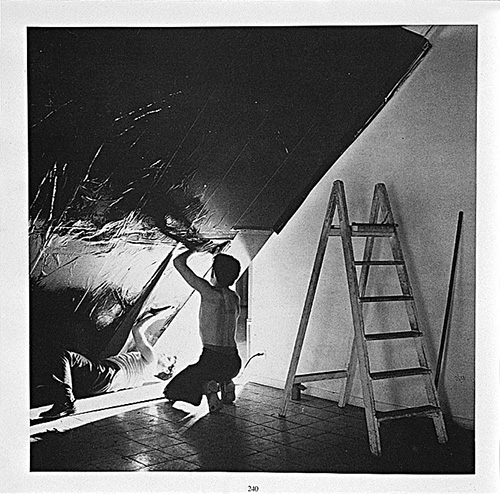
“Teatro delle mostre” Roma, 1968 – Courtesy Archivio Alighiero Boetti
In early spring Boetti took part in various group exhibitions including “Arte Povera” curated by G. Celant at the Galleria de’ Foscherari in Bologna. He exhibited Panettone and produced the poster Città di Torino: a plan of the city in which the streets are indicated with the colored names of the artists resident in them, including himself. The map was included with the exhibition catalog and distributed to the public.
AB also took part in two important group exhibitions in Rome, “Il percorso” and “Teatro delle mostre.”Both consisted of sequences of performances.
“Il percorso” was organized by Mara Coccia, director of the Galleria l’Arco d’Alibert. She invited the Turin-based artists Anselmo, Boetti, Merz, Mondino, Nespolo, Paolini, Piacentino, Pistoletto and Zorio to perform a sequence of events. “At the private viewing there were the artists but no works, because they were created before the eyes of the public on the three days of the happening.”
Boetti built three Colonne in the gallery, using thousands of scalloped paper napkins which he got from a cake shop, strung on three iron rods. The work was documented in a photographic record by Mario Cresci.
“That same day an exhibition of Pino Pascali’s was opening at the Attico. He was showing his Silkworms. Pino and I were really doing the same thing, in fact we were amazed. When I went out to buy the paper napkins at the cake shop, he went round to the drugstore for the colored brushes that he arranged next to each other. We had reached the limits of a certain potential…”.
The “Teatro delle mostre,” curated by Maurizio Calvesi, was held at the Galleria La Tartaruga run by Plinio de Martiis. He recalled the event: “The gallery was transformed into a laboratory… It looked like a stage or a film set.” The exhibition, originally subtitled “An exhibition every day – from 4 to 8 p.m.,” consisted of a series of performances with the direct involvement of the public. AB presented Un cielo: “Boetti … assembled a big frame covered with dark blue paper and the public were given the nails. Behind the frame there were spotlights. The nails were used to pierce the dark blue surface … and everyone produced his own constellation.”
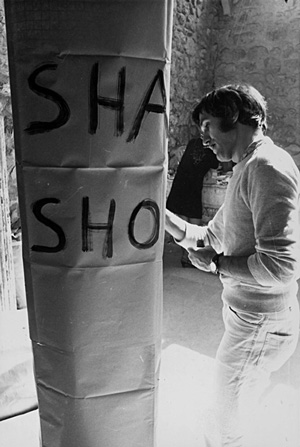
Alighiero Boetti in Amalfi for “Arte Povera più povere actions”, 1968, Courtesy Lia Rumma
Plinio de Martiis, working in his own special tradition, asked the artists to produce a sign for the performances. At this time in Turin the “Deposit of Art of the Present” was set up. Some photos in the archives show displays of works by AB: Panettone, Legnetti colorati, a castiron work Boetti set on the wall and some plexiglas Cubi filled with various materials.
On 23 April, at Franco Toselli’s Galleria De Neuburg in Milan, Boetti had a solo exhibition with a presentation by T. Trini. The title of the exhibition, “Shaman-Showman,” corresponded to a photomontage which was enlarged as the exhibition poster and displayed in the streets (there also exists a smaller silkscreen edition). Boetti later commented:
“Showman and shaman, because you are always a wizard when you work with head and hand… And showman because every so often you have to be one!”
Conspicuous on the floor, transformed into a dry stream bed, were Colonne, Un metro cubo, Panettone, Legnetti colorati (initially titled Aiuola / “Flower bed”), a Pack galleggiante (an ephemeral work, like the general installation) and, concealed, Ritratto in negativo.
If this exhibition at the Toselli gallery represented the peak of the artist’s involvement in Arte Povera, the autumn exhibition in Amalfi, “Arte Povera più azioni povere,” organized by Marcello Rumma and curated by Germano Celant, marked its most extreme form. Boetti’s participation was described by Gilardi in these terms: “At the Arsenal, Boetti had accumulated and spread out in front of the entrance about thirty gadgets and samples of materials which, all labeled by his gallery, were on a square of white fabric placed on the ground.” The exhibition marked a radical breakthrough as he turned away from Arte Povera:
“With Shaman-Showman I quit. Then I did the work on squared paper using a tracing pencil… By the Amalfi exhibition I was really fed up with it all.”
In fact the Amalfi installation included some strongly conceptual works.
“There were three blue panels with three Dates, which I had requested from three women, referring to a future which interested them. They included Anne Marie… I had some idea of the energy a date can convey.”
Of the three dates, only one refers to the past, the others represent expectations, a rendezvous with the future.
“Dates? You know why they’re very important? Because, for example, if you write ‘1970’ on a wall it seems like nothing, but in thirty years’ time… Every day that passes this date becomes more interesting, it’s time at work…”.
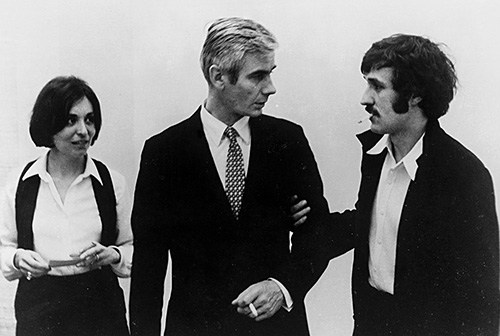
Alighiero and Annemarie Boetti and Enrico Castellani at the inauguration of “Shaman/Showman”, photo by Enrico Cattaneo
“Time at work”: in ’68 AB made a wooden panel with 1978 written on it and subtitled “art in ten years’ time.” The following year he carved on a wooden diptych a “continuing tombstone”: the centenary of his birth and the supposed date of his death.
Time and writing: again in ’68 AB performed a number of “poor actions” that consisted in writing in quick-setting concrete verses taken from Herodotus (Verso sud l’ultimo dei paesi abitati è l’Arabia / “To the south the last of the inhabited countries is Arabia”), from Marcuse (Per un uomo alienato / “For an alienated man”), from Rimbaud (J’ai embrassé l’aube d’été). The swift time of writing against the time of matter. Strangely enough all these works were only made public and exhibited twenty years later.
1969
22 March, Berne: the opening of “Live in Your Head. When Attitudes Become Form,” curated by Harald Szeemann. The groundbreaking exhibition compared new trends in America and Europe by looking at Conceptual Art, Land Art and Arte Povera. AB exhibited Alighiero prende il sole a Torino il 24-2-1969, Tavelle, Luna (lost work). In the catalog, on the pages placed at his disposal, he added photographs of other works (also now lost), Sole meunière, Tritella, and a double photographic self-portrait: himself lying on the floor of his studio next to the Portrait in Negative made out of stones.
On 19 April, at the first solo exhibition in the Galleria Sperone, AB presented three works in mixed media: Io prendo il sole a Torino il 24-2-1969 (its second title, later definitively modified to Io che prendo il sole a Torino il 19 gennaio 1969), Portrait of Walter de Maria, Vetrata (which reduced in size became Niente da vedere niente da nascondere). The invitation on paper reproduced the photograph San Bernardino, a portrait of Boetti with one hand open and one closed.
In May, again at the Galleria Sperone: AB took part in the group exhibitions “Disegni e progetti” with Territori occupati, a work embroidered on which returned to the first of the geo-political “forms” begun in 1967. The embroidery was sewn by Annemarie Sauzeau.
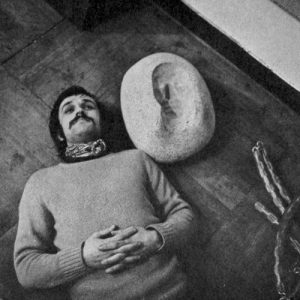
Alighiero Boetti near his self-portrait in negative, 1969
“In spring I left the studio I had in Turin, which had become a storehouse of materials, Eternit, pieces of concrete, stones… I left it all just as it was. I took the squared paper. The Cimento dell’armonia e dell’invenzione consists of redrawing the squares.”
AB began a new series of works. The first example of Cimento dell’armonia e dell’invenzione was also called 42 ore and was supplemented by a recording of the silence and soft noises during the time it took to make. It was exhibited in late September at the “Prospect 69” exhibition at the Stadtische Kunsthalle in Düsseldorf.
The title of this type of drawing refers to Vivaldi’s Opus no. 8, containing the twelve concertos which include the Four Seasons, and a type of music played by AB himself. “In the period Alighiero played a lot of music, he played tabla drums, practicing with compositions based on the proliferation of numbers as musical rhythms. He interpreted ‘Cimento’ (‘contest’) as meaning this type of exercise, how to do musical scales, which was also a ‘contest’ on paper.”
15 July, Turin: his first child, Matteo, was born.
In summer AB began a work in progress, the Viaggi postali. He created twenty-five virtual routes for twenty-five “travelers,” who were friends, collectors and artists, including Marcel Duchamp (who had recently died), Bruce Nauman (whom he met at the exhibition “Live in Your Head. When Attitudes Become Form”), his friend Paolini, the critic Argan and his newborn son Matteo. The work consisted in imagining the addressees had traveled to various places, 181 in all, and then sending them letters they would not receive, since they were obviously not resident at the addresses chosen.
The letters that returned undelivered to the sender, AB, would be put in ever larger envelopes and forwarded to the other points on their journey (the first envelope contained the complete itinerary). The result was twofold. On the one hand the twenty-five final envelopes containing all the preceding ones constituted a single work, called Viaggi postali (“Postal journeys”). On the other the xeroxed copies of recto and verso of the envelopes, made each time before posting the letters again, testified to the 181 stages and constituted the Dossier postale, creating an edition of 99 copies of no fewer than 36,000 photocopies, curated by AB and Clino Trini Castelli.
The Dossier postale recounts the twenty-five imaginary journeys enclosed in the final parcels. The numbering of each example appears, again on file number 181, in a stamp, devised by Clino Trini Castelli, which refers to “file 104,” meaning the last stage of the journey by Bruce Nauman.
“It’s one of the finest works I’ve ever done. Really complicated, it lasted a year.”
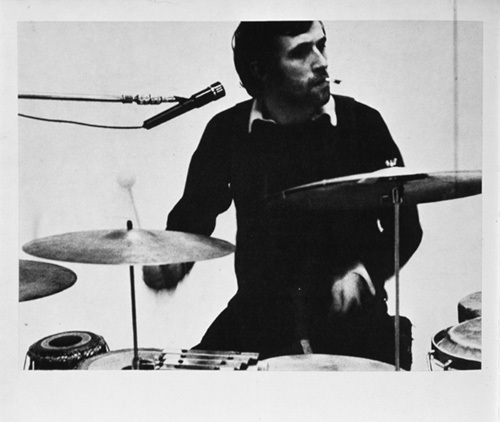
Alighiero Boetti on his drums in the Sperone gallery, 1969, photo by Paolo Mussat Sartor
In autumn he took part in various group exhibitions, lavishing particular care on the catalogs, which at the time were considered by artists as works in themselves, self-sufficient art projects. He worked on the xerox “portraits” Autoritratto and Ritratto di Annemarie, consisting respectively of twelve and nine photocopied sheets, which all show the artist’s face intent on communicating in deaf-mute alphabet. He also turned his hand to other experiments, again using a photocopier, for example by letting some chicks wander about on the surface of the photocopy panel.
“I’d go round to the Rank Xerox showroom and pay my hundred liras a copy…”.
On an old map printed in black and white, AB colored in the various countries using the colors of their flags. This Planisfero politico (in two variants) was the starting point, developed in 1971, for his later embroidered maps. At the same time he planned to have a globe made, of sizable dimensions, which would show only the contours of the land and sea beds, without the presence of water. The outlines of the continents would not be perceptible, so the effect would be like the surface of the moon. It was never made because it proved impossible to obtain accurate scientific data about the features of the seabed, which was classified information during the cold war. There survive two small plaster reliefs, fragmentary models of the initial project.
1970
Boetti completed the series of Viaggi postali over the course of the year. Part of Dossier postale had already been presented in Bologna at the “Terza Biennale Internazionale della giovane pittura” in January. Boetti began his first works based on permutations and combinations of stamps. His first Lavoro postale, based on three different stamps (with six possible combinations, hence six envelopes), was sent to the Galleria Sperone.
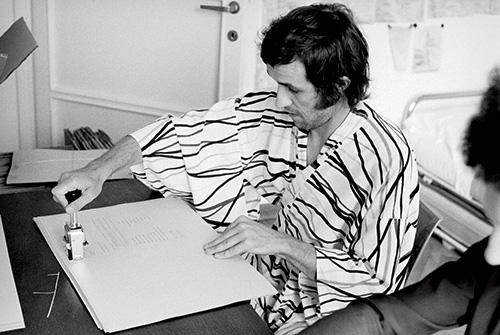
Alighiero Boetti during the Dossier, Milan 1970. Photo Giorgio Colombo
In Munich that April, during the survey “Aktionsraum 1,” Boetti carried out a sequence of actions which included giving a lecture in two languages, Esperanto and Italian, followed by the gradual tearing up of a sheet of paper on the principle of Raddoppiare dimezzando (doubling by halving); then, finally, for the first time, he did two-handed mural writing, simultaneously towards right and left, using the text puntopuntinozerogocciagerme.
Cimento dell’armonia e dell’invenzione (varied across numerous sheets of paper) and Millenovecentosettanta (EMEIELLE … the spelling of the year 1970) were his most innovative works. They were presented at all his solo or group exhibitions in Europe and defined the birth of conceptual art.
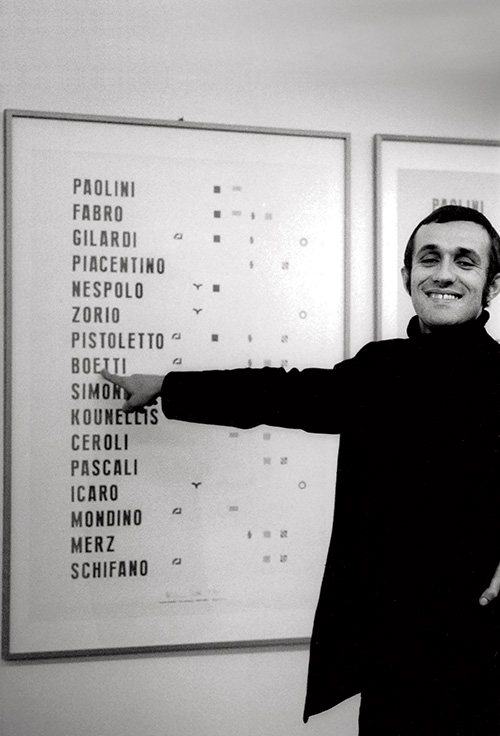
Alighiero Boetti in front of the Manifesto at the Franco Toselli gallery in Milan 1970, photo by Paolo Mussat Sartor
Of Millenovecentosettanta, a square of forty-nine letters, exists a version in lace and others made of wood or cast iron. AB sprayed green paint over the latter for every installation and the halo that spread beyond the limits of the square united the iron and the wall in a single “cloud.” This arrangement of a date as a square was the source of all his language squares in subsequent years.
In “Conceptual Art, Arte Povera, Land Art,” an international exhibition curated by G. Celant at the Galleria Civica d’Arte Moderna in Turin, AB exhibited a castiron version of Millenovecentosettanta. It was also the image printed on the exhibition posters. Among the other conceptual exhibitions, a major event was “Processi di pensiero visualizzati” at the Kunstmuseum in Lucerne, curated by J.C. Ammann. In the pages placed at AB’s disposal in the catalog, he presented four spare drawings linked to four poetic quotations from Johnson, Yeats, Roheim and Hopkins.
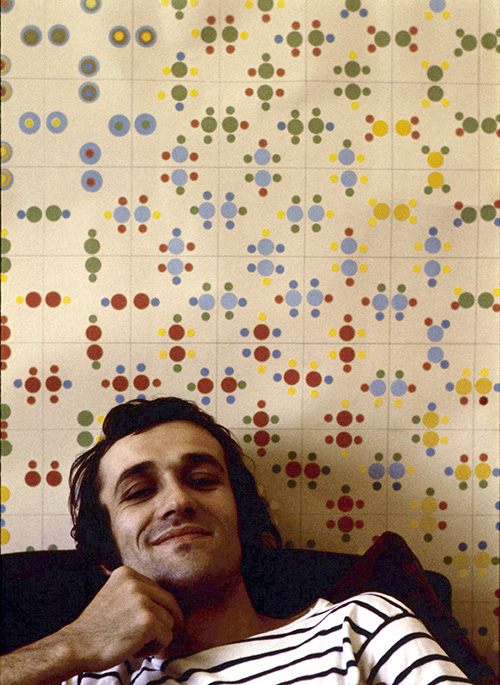
Alighiero Boetti, 1970, photo by Paolo Mussat Sartor
He continued to experiment with squared paper. After the tracings and word squares, in 1970 he adopted a new approach: using plain sheets of copybook paper, he began writing with commas, a system he developed further in 1972 in his works in ballpoint pen.
All through the summer he withdrew, “encamped” in Franco Toselli’s Milan gallery, “closed for the holidays.” He took to its extreme development the interplay of mirrored combinatorial marks on a checked surface, which he had begun in 1967 on a wooden checker board and continued with colored marks on sheets of drawing paper. In this way he created Estate 70 (“Summer 70”), a roll twenty meters long, covered with thousands of self-adhesive stickers. He again adopted the same colored mechanism in a project using bathroom tiles, but never completed it.
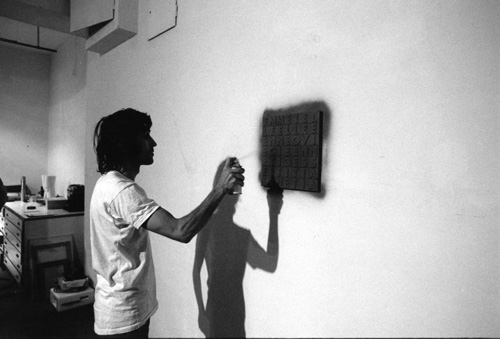
AB while spraying Millenovecentosettanta, 1970, photo by Giorgio Colombo
At the end of the summer, in his passion for serial works, AB planned to place geographical features in progressive (decreasing) order, with a classification of the rivers of the world which went well beyond the modest lists found in encyclopedias. His wife was involved in the project. In October Annemarie Sauzeau started to draw up a list of the world’s one thousand longest rivers. She made preliminary contacts for publication with the Istituto De Agostini in Novara and the Geopaedia project at Pergamon Press in London, and acquired complex unpublished scientific data through correspondence with geographic institutes and university departments in Africa, Latin America and Asia. The long project was brought to completion in 1974 with the final classification, while it took another three years for the publication of Classifying, the thousand longest rivers in the world, a volume of over a thousand pages. The idea behind the project was clear from the start:
“It’s a linguistic work which grew out of the idea of classifications. It’s based on measurements. Geography has nothing to do with it.”
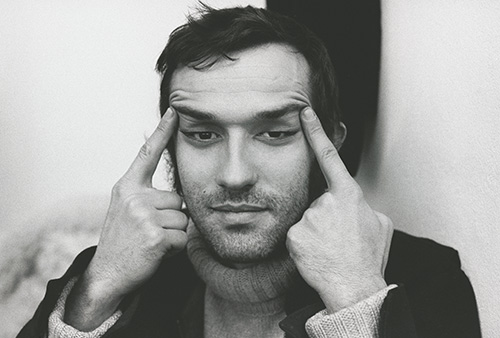
Alighiero Boetti at the inauguration of the exhibition of Mel Bochner – Galleria Toselli of Milan, 1970, photo by Giorgio Colombo
AB’s conceptual position emerged clearly throughout 1970. For example, in autumn at the Kunstverein in Hanover, AB participated with a performance in the video survey identifications, organized by Gerry Schum. In it he stood with his back to the camera and wrote on the wall with both hands simultaneously the sentence: Giovedì venti quattro settembre mille nove cento settanta (“Thursday the twenty- fourth of September one thousand nine hundred and seventy”). Already in March, Paolo Mussat Sartor photographed Alighiero Boetti in his house on Via Luisa del Carretto writing the date on the wall with both hands Oggivenerdiventisettemarzomillenovecentosettantaore.
In Rome the year closed with his participation in an important group exhibition: “Vitalità del negativo 1960–70,” curated by Achille Bonito Oliva, organized by the Incontri Internazionali d’Arte at the Palazzo delle Esposizioni. Boetti exhibited a series of sheets from Cimento dell’armonia e dell’invenzione.
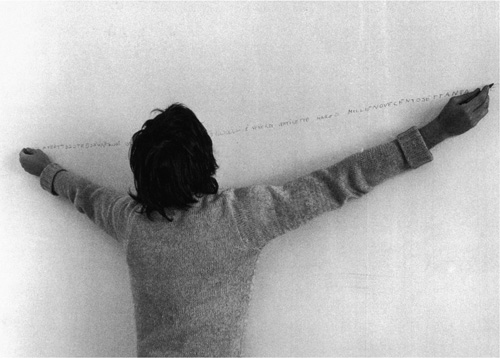
AB two-handed writes 1970, photo by Paolo Mussat Sartor
1971
With the addition of the newly founded state of Bangladesh in March 1971, he completed a work in progress begun in 1967, a collection of geopolitical maps. The final work, titled Dodici forme dal 10 giugno 1967, made on copper plates, engraved after the model of his tracings on paper, was exhibited at the Galleria Sperone in summer. In autumn an edition printed on paper was issued.
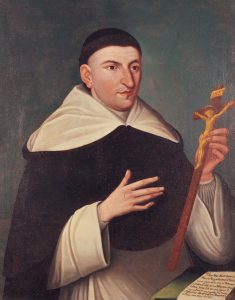
Portrait of Giovan Battista Boetti, 1743-1794
Meanwhile, in late March AB left for Afghanistan and stayed there several weeks. This was the beginning of a ritual of making two visits every year which continued up until 1979. He chose Afghanistan for various convergent reasons. One was that an ancestor of his, the Dominican friar Giovanni Battista Boetti (born in Monferrato at Piazzano in 1743) had been sent to Mosul at the head of the Evangelical Mission for Asia Minor. Subsequently he converted to Sufism, Persian Islamic esotericism, and was considered an apostate by the Roman Church. Calling himself the Prophet Mansur he became one of the heroes of the resistance against Tsarist imperialism in the Caucasus, with risings from Armenia to Chechnya. Two centuries later there appear extraordinary parallels between the two Boetti, both in the splitting of their identities and their geopolitical interests.
Two months before setting off for Afghanistan, AB duplicated the sole existing portrait of Giovanni Battista Boetti as a young Dominican friar and added it to the catalog of the group exhibition “Formulation” (Addison Gallery of American Art, Andover), next to another “indirect self-portrait”: his own profile in a very Pop version in a wooden silhouette, painted in 1970 by the Turin-based painter Pietro Gallina, which the artist loved to present in exhibitions among his own works. AB gave other possible reasons for going to Afghanistan:
“My interest in distant things wasn’t strong when I became an artist. I thought of travel in strictly personal and hedonistic terms. The principal factor in its allure was very precise: I was fascinated by the desert, and not just the natural desert. In an Afghan house for example, there’s nothing: not a single piece of furniture, hence none of the objects that are usually placed on furniture… What attracted me most was the blankness, the civilization of the desert. Afghanistan is a country of mountains, where villages are built on mountainsides so as not to waste the fertile land in the valleys. Nothing is added to the landscape. They clear the stones and use them to build their cube-shaped houses, as in Paul Klee’s watercolors, and they lop the branches off a tree to make the loadbearing structure.”
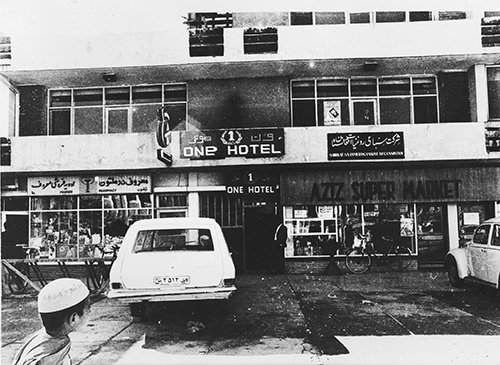
One Hotel in Kabul, courtesy Archivio Alighiero Boetti
In Kabul he had two squares of fabric embroidered with two dates, 11 luglio 2023 – 16 dicembre 2040, based on the diptych made previously in two versions, one of lacquered wood and the other brass.
This was the first of the embroideries he commissioned from Afghan women. On returning to Italy, in May he exhibited the diptych in the brass version at “Arte Povera – 13 artisti italiani,” a group exhibition held at the Munich Kunstverein. For the catalog AB asked (in vain) for the four pages at his disposal to be replaced by a single white sheet of industrial paper, of the equivalent weight, with nothing but his name printed on it.
Meanwhile, on 4 May, by sending the first telegram (“2 days ago it was 2 May 1971”) he began an essential work: the sequence of telegrams that was to form the Serie di merli disposti a intervalli regolari lungo gli spalti di una muraglia (“Series of battlements arranged at regular intervals along the ramparts of a wall”). It is based on the rule of doubling the time intervals after the initial date (2, 4, 8, 16…). AB immediately designed a special display case to contain the greatest number of telegrams that could be sent in his lifetime. The fourteenth and last one would be sent by the artist in 2017, when he would be seventy-seven years old. The space for the last of the “battlements” was left empty in the “wall.”
At the end of summer, in the exhibition curated by Achille Bonito Oliva for the International Theater Fes- tival in Belgrade, Boetti repeated his two-handed mural writing performance.
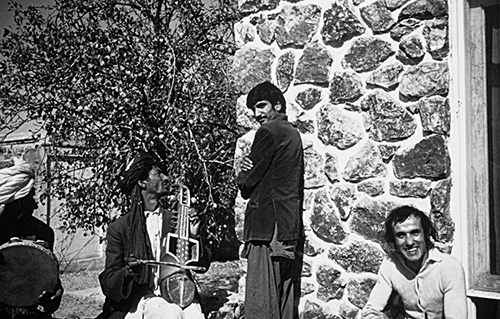
Alighiero Boetti with musicians at One Hotel in Kabul in 1971, courtesy of Alighiero Boetti Archive
In September AB returned to Kabul, taking some pieces of linen, on which he had impressed a map of the world by photographic projection, colored according to the national flags (like the Planisfero politico, his earlier work on paper dating from 1969). The young ladies at the Royal School of Needlework took a whole year to complete the large Mappa and six months for the smaller ones.
At the same time further maps were commissioned from a family in the village of Istalif. The preliminary work for the embroidery was always done in Italy.
Every minor detail was specified: the forms of the continents and the boundaries of states, the forms and colors of the flags, the changes over the years to national boundaries and flags to reflect political changes—even variations in the rules of the projection of the earth’s curvature. In the early years the date registered on the embroidered selvage marked the completion of the embroidery in Kabul. After ’79 the date was generally inserted in Rome together with the mapping, so it marked the beginning.
The postal works with Italian stamps were followed by the first with stamps from Afghanistan.
During his stay in the country he created One Hotel, in a small mansion house with a garden in the Sharanaw residential quarter of Kabul. Its address was Zarghouna Maidan. An initiative of this kind was fairly simple under the monarchy of Zahir Shah. Its management was entrusted to the young Gholam Dastaghir, who had some [experience in the business. The hotel shared the fate of the country. It had to close a few years later, long before the official Soviet occupation.
Returning from Afghanistan, on 24 September AB exhibited at the Italian section of the Biennale de Paris, curated by A. Bonito Oliva. At its close, the same works (Viaggi postali, Dossier postale and Dodici forme dal 10 giugno 1967) were exhibited in Rome at the Incontri Internazionali dell’Arte, in the group section titled “Informazioni sulla presenza italiana.”
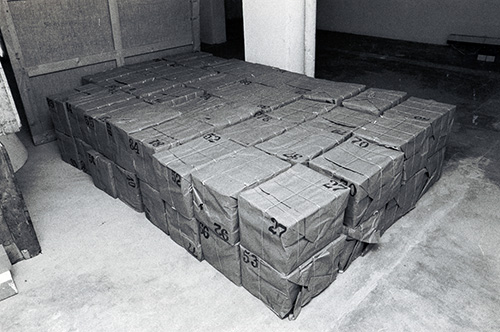
The 99 Postal Dossiers completed in Milan in 1971, photo by Giorgio Colombo
In the same period AB began to produce works written in blue ballpoint pen on white cardboard which played on his name and identity: AB, ALIGHIERO BOETTI MADE IN ITALY, ABEEGHIIILOORTT, AELLEIGIACCAIEERREOBIOETITII. Then finally he began to split his identity in two by inserting “and” in his name, hence writing it “Alighiero e Boetti.” In this way he expressed the equivocation created by the photo of his twin selves in ’68. Various statements he made show that the decision was a true conceptual operation:
“I always worked on the half and the double, and the missing unity—something that never exists. I used this mechanism in various works, including one like my first name and surname by putting ‘and’ between them… They become two people, and not just linguistically but really, because some people actually think I have a twin—and it’s true.”
Boetti created the language square Ordine e disordine on paper in 1971. Its material composition differed from the square titled 1970, sprayed with paint on paper. It was created as a negative, the color being sprayed over the surface but was covered by a template bearing the lettering. Apart from the formal composition of sixteen letters, the concept conveyed by the two words was of fundamental importance in the artist’s thought:
“I worked a lot on the concept of order and disorder, disordering order or ordering certain kinds of disorder, or presenting a visual disorder that was actually a representation of mental order. I think everything contains its opposite, we always have to seek one in the other: order in disorder, the natural in the artificial, shadow in light and vice versa.”
1972
In February Boetti had a solo exhibition at Franco Toselli’s gallery in Milan, “Franco Toselli c/o Alighiero Boetti.” Some postal works were exhibited, notably Centoventi lettere, presenting 120 stamped envelopes based on the number of permutations possible starting from five, in this case five Italian stamps of different values and colors. This was the first postal work in which the envelopes contained “messages” to be exhibited outside the envelopes: 120 sheets of tissue paper, each with a puzzle-drawing (Pack) in black ink. The drawings removed from the envelopes were bound in a volume with a red cloth cover.
On 16 March Agata, his second child, was born.
After spending spring in Kabul, AB brought back to Italy the first medium-sized embroidered Mappe (of the two larger Mappe, one was completed the following autumn, the other only in spring 1973).
“The first reactions were terrible. People were annoyed. It should be said that few artists at the time had their pieces made by craftsmen. The public of the day found it both embarrassing conceptually and too ‘pretty.’ But all the collectors wanted one!… I come from Turin, I’m a northerner, and in those days I was a lot more rigorous, far too rigorous. To the point where I never used color in my work. Living in Rome did me good. I then opted for openness, generosity, and freed myself from that excessively rigorous idea that you should only make a single work out of a single idea. It was Gian Enzo Sperone who finally convinced me… From then on I took the opposite approach, profusion. I turned to serial art.”
The May issue of Data magazine carried a detail from a Mappa on its cover. The same issue had an article by Tommaso Trini titled “Abeeghiiilooortt.”
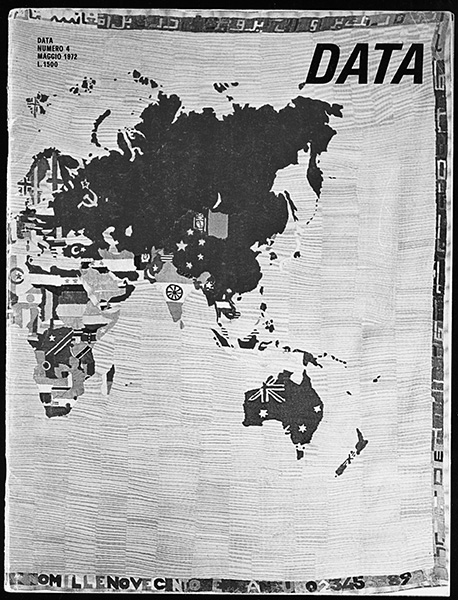
The journal Data, May 1972
18–30 June, “Alighiero e Boetti,” solo exhibition at the Galerie MTL in Brussels. This was the first time Boet- ti’s name was given this form.
In summer AB presented his work at four important group exhibitions held at close intervals. On 29 April, “De Europa” (a group exhibition of thirteen Euro- pean artists) at the John Weber Gallery in New York exhibited Dodici forme dal 10 giugno 1967. On 11 June, at the 36th Venice Biennale, curated by Achille Bonito Oliva, Boetti again did his two-handed writing performance.
On 23 June, at the Festival of the Two Worlds in Spoleto, in the exhibition “420 West Broadway at Spoleto Festival,” he exhibited the sequence of Dodici forme dal 10 giugno 1967. Finally, on 30 June at the fifth edition of the Kassel Documenta, curated by H. Szeeman, he presented a highly complex Lavoro postale, the first made by starting from six (Italian) stamps of different values and colors. The number of possible permutations enabled the artist to present 120 envelopes, stamped and obliterated, addressed to the Galleria Sperone. In the same period he actually undertook the permutations of seven (Italian) stamps, giving 5,040 possible combinations, hence 5,040 envelopes addressed to himself as Victoria Boogie-Woogie.
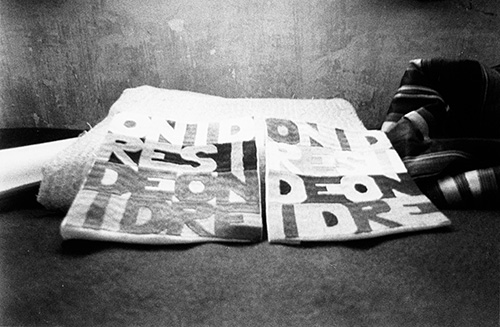
Order and disorder, Kabul 1972, photo by Annemarie Sauzeau Boetti. Courtesy Agata Boetti
In Kabul in September Boetti arranged for the embroidering of a first small word square, Ordine e disordine, measuring about 20 × 20 cm, embroidered in many colors. He also started another type of embroidery whose title, I Vedenti (“The Sighted”) refers to the central lettering, which is interwoven with the colorful ground and so barely perceptible.
In October, returning to Italy, he joined his wife and children at their new home at 38 Via del Moro in Trastevere, Rome.
He began the cycle of ballpoint works done “in negative” (with the blank “reserve” emerging against a ground hatched in ballpoint). He again wrote his name in different ways, both by using the letters of which it was composed and by playing with the letters of the alphabet and commas. The structure of all of his works in biro “written” in white commas meant that each comma was given the value of a letter, being deciphered on the basis of Cartesian axes: one variable consisted of reading from left to right and the other of the letters of the alphabet.
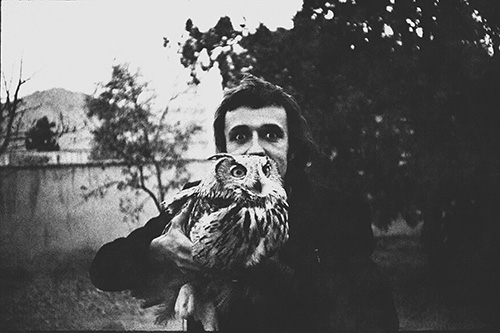
Alighiero Boetti and the owl Rémè in Kabul in 1972, Courtesy of Alighiero Boetti Archive
He wrote AEB, ALIGHIERO, AIIEOOEI/LGHRBTT (separating vowels from consonants). Finally in ’73 there appeared Ononimo, the supreme variant of his identity, a neologism fusing the Italian words for “homonym” and “anonymous.” It was presented in sequences of eleven inseparable sheets (11 being his favorite number) in blue or red, while other versions of Ononimo are single or “isolated” (with AB writing “isolato” next to his signature). The background, hatched in with ballpoint, was a long, laborious work and was delegated to other hands, precisely because the anonymity and variety of the “hand” were part of the project, though with a trace of irony the artist suggested other reasons:
“I often get other people to do the work, even though I’d really like to do it myself. I’d love to be able to go out in the countryside with a sheet of blank paper and take six months filling it in. I’d like to but I can’t. I just can’t do it, after two minutes I’d go crazy. But since I like the thing in itself, I find some people to do it, rather like in Muslim countries, where if you can’t go to Mecca you pay someone who goes for you and says your prayers, he does it all for you…”.
The first person he asked to do the work was a friend in Turin, Gigliola Re. When Boetti moved to Rome, she immediately found him another collaborator there.
Number 62 of Bulletin, a magazine published by the Art & Project Gallery in Amsterdam, was devoted to Boetti. It had a black and white two-page spread illustrating one of his postal works: six envelopes from Afghanistan addressed to himself in Turin.
1973
On 20 January, the group exhibition “Eight Italians,” organized by Sperone, opened at Art & Project in Amsterdam and MTL in Brussels. Boetti exhibited with De Dominicis, Merz and Zorio (the other subgroup comprised Anselmo, Paolini, Penone and Salvo). Besides a postal work, AB exhibited two of his first works drawn in negative in ballpoint, ABEEGHIIILOORT and ALIGHIERO E BOETTI, a “sculpture” from 1971 made up of three elements in silver titled Tre and a calligraphy Millenovecentosettantadue.
In February, at the Galleria Marilena Bonomo in Bari, he had a solo exhibition “Alighiero e Boetti. Il progressivo svanire della consuetudine.” AB exhibited the postal work Quadratura del dieci (1972). This was a “self-arrangement” of sixteen envelopes, and some of the new works in ballpoint, particularly the one that gave the title to the exhibition.
In March AB had his first solo exhibition at the John Weber Gallery in New York. On display were a Mappa and two Lavori postali, including Victoria Boogie-Woogie. Apart from a review by Bruce Boice in Art- forum, the exhibition failed to attract much interest. Soon after the New York inauguration, Boetti left for Kabul. He returned to Italy in the company of a young Afghan, Salman Ali, who lived with him and his family until the artist’s death.
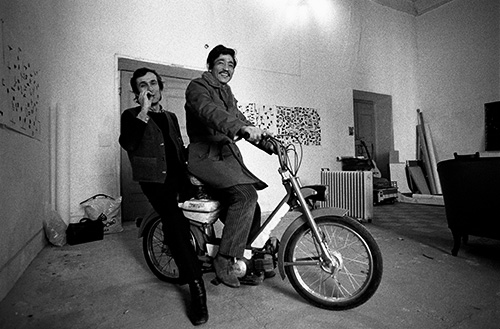
Alighiero Boetti and Salman Ali in the study of Piazza S. Apollonia 3, 1975, photo by Giorgio Colombo
In spring he moved from his home at Vicolo del Moro 38 for the nearby Piazza Sant’Apollonia, where, besides an apartment, he had a large studio. The windows gave onto Piazza Santa Maria in Trastevere and looked towards the Romanesque church.
In May, in a solo exhibition at the Galleria Sperone-Fisher in Rome, Boetti presented four important works: one Mappa, the Serie di merli disposti ad intervalli regolari lungo gli spalti di una muraglia was shown for the first time and two large works in blue ballpoint: Il progressivo svanire della consuetudine and the dip- tych Mettere al mondo il mondo.
In the same month, at the 10th Quadriennale Nazionale d’Arte in the Palazzo delle Esposizioni he presented two works from his Arte Povera period, Lampada Annuale and Manifesto, together with a recent Lavoro postale of 492 envelopes.
On 7 June, with a solo exhibition at the Galleria Toselli, he confirmed a characteristic already perceptible in his solo show of the previous months: his postal works, ballpoints and embroidered maps were by this time parallel typologies enriched by overlaps and affinities. The manual phases of this highly diversified work was partly delegated to others—the embroidery in Afghanistan and ballpoints in Rome—while the artist personally dealt with all phases of the postal works, notable for the use of the different kinds of stamps available in the various countries where he stayed. The Serie di merli disposti ad intervalli regolari lungo gli spalti di una muraglia was again exhibited, and Giorgio Colombo took a photo of the work in progress.
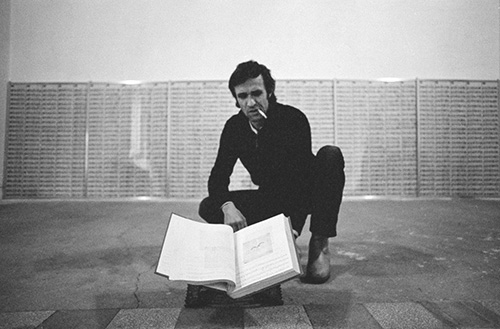
Alighiero Boetti prepared in 1978 at the Kunsthalle in Basel “720 letters from Afghanistan”, realized in 1973-1974, photo by Gianfranco Gorgoni
The ballpoint works were stepped up after the summer, when AB commissioned Mariangela De Gaetano not only to do the hatching in biro herself on a number of sheets (the various signs, letters of the alphabet, commas or words were always drawn by the artist himself) but also to organize and coordinate the work by others.
She recounted: “I chose people from all quarters of the town, of all ages, and they all worked in different ways. The only rule they had to follow was not to let the white appear between the hatching. For the rest, they could do the work as they wanted… Some people drew thicker lines, some people stiffer, others did the work more mechanically, lost in thought, daydreaming, a bit like automatic writing. Boetti often wouldn’t let me tell him who had done a sheet, he liked to guess. He recognized the line of a woman. Then he used to ask me about all of them, who they were and what they did in life. The work took a long time. Personally I took a year to complete the first one, a single sheet measuring a meter and a half out of more than 4 meters, Il progressivo svanire dalla consuetudine.”
The first ballpoints done in Turin were exclusively in dark blue ink, while in Rome he used black, red and green. In the first compositions the text can be discovered by relating commas and letters (reading vertically or horizontally). This is the case of Mettere al mondo il mondo (consisting of two or five elements), Immaginando tutto (two elements), I sei sensi (eleven elements), Il progressivo svanire della consuetudine. The same mechanism was applied to the “portraits” based on the names of friends and often consisting of whole families. Meanwhile he continued with the type of composition with words written in full at the top of the sheet, including ONONIMO, or dates written in words.
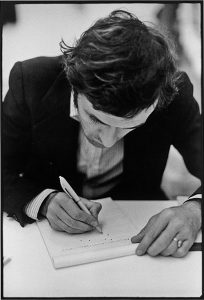
Alighiero Boetti realizes the portrait of Giorgio Colombo at the Franco Toselli gallery in Milan, 1973, photo by Giorgio Colombo
These inscriptions were chosen on various criteria: at times they were the titles of other kinds of works he did (Dare il tempo al tempo, Raddoppiare dimezzando). At times they were quotes, such as the mystical Sufi saying La notte dà luce alla notte (“The night gives light to the night”). The writing of these sentences in ballpoint, in a number of versions but all different in coloring and hatching, continued through the following years. In his Rome studio AB prepared the sheets for the ballpoints while his private research continued to be focused on squared paper, working on language squares and the transformation of sentences into “constellations” of commas.
In the periods spent in Kabul, he oversaw the work on the embroideries and at the same time at the One Hotel prepared his postal works, the drawings to be inserted in the envelopes and the permutations of stamps. The most challenging of the postal works produced in Afghanistan was definitely 720 lettere da Kabul. Prepared in autumn ’73, it consisted of 720 sheets prepared by AB, to be completed with a phrase in Farsi. Dastaghir was commissioned to write these phrases and then send them to Rome in the course of the long Afghan winter of ’73–’74.
“When the hotel business fell through because of the revolution and everything got eliminated, including hotels, my partner was there, with winter approaching, jobless and without a cent.
So I organized this colossal work and asked him to write a page a day during those months, putting down the events of his life, his childhood, memories, stories… I prepared it all, envelopes, stamps, a really long job. And then I gave him 720 sheets which I had stamped, using a rubber stamp I had made specially. It was the image of the number one thousand…”.
Besides the Mappe, in Afghanistan Boetti had the works Ordine e disordine embroidered, no longer as a single small tapestry but with a view to creating large composites made up of several pieces, all bearing the same phrase but in each case colored in different ways. (One composition was made up of forty-nine pieces and another of a hundred.) Other “small embroideries” followed in the years ahead.
“I drew about 150 sentences that could be arranged in squares… Today when I come across an expression like ‘la forza del centro’—a yoga precept—I know instinctively that the number of letters enables it to form a square.”
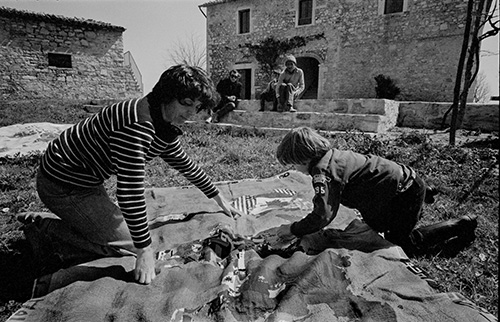
Alighiero Boetti looks at his Maps in the family in Todi, photo by Gianfranco Gorgoni, 1975
In late November “Contemporanea” opened in Rome, curated by Achille Bonito Oliva in the new car park at Villa Borghese. The works by Boetti on display were Ping Pong and Dodici forme dal 10 giugno 1967. Caroline Tisdall, in the London Arts Guardian, reviewed the exhibition as the “biggest ever mounted in Italy, with almost one hundred artists, a true challenge to Kassel.”
Of Boetti she wrote: “… Alighiero Boetti conveys the sense of the artist as a removed figure, somehow anonymous but observing and recording events in the ‘real world.’ One of his works on show is a series of etched copper plates: sections of maps. They are in fact the maps, one to a plate, of all the places in the world in which some political atrocity happened over a period of time a couple of years ago. So discreet is the use of material that the unmarked maps become shapes on a plate unless you know the circumstances in which they were done.” AB bought a house in the countryside not far from Todi in Umbria. It was to become his point of emotional and domestic stability, to compensate for the nomadic restlessness of his “twin” self.
1974
AB had already spent two years thinking about the need to create a portfolio that would bring together drawings and projects of past and present activities.
He involved the printer Rinaldo Rossi, who had already worked with him in ’67. When completed in ’76, with eighty-one plates, the portfolio was given the definitive title Insicuro noncurante. Perhaps while he was working on this, the artist realized that some works related to the drawings he was collecting had been lost. They were the works exhibited in his solo exhibition at the Galleria La Bertesca in Genoa in December 1967 and reproduced in the catalog. He therefore authorized in writing a friend of his, a Milanese art dealer, to remake “the works in concrete produced in 1967 which have been destroyed. Firstly: 100 quadrati and A coltello.” But these works were never remade and today only period photographs of them remain.
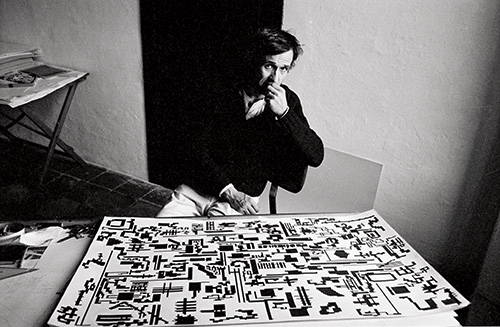
Alighiero Boetti in front of the Natural History of Multiplication in his studio in Trastevere, photo by Gianfranco Gorgoni
The spring issue of Data carried an article by Tommaso Trini titled Alighiero Boetti: The World’s 1000 Longest Rivers. The Boetti had almost completed the classification.
In April, Boetti traveled to Afghanistan with Francesco Clemente. In May at the Lucerne Kunstmuseum, AB participated in the group exhibition “Ein Werk für einen Raum” (each artist presented a single work in a room measuring 7 × 7 meters), curated by J.C. Ammann, where he showed the large Dama. In the catalog Ammann wrote: “Form does not mean formalization, an abstract plan of the work. Always starting from life, Boetti gives the work a richness of aspects whose formalizations, often lapidary, are the hallmark of the cosmos: Ordine e disordine arranged in a square is an example.”
The curator saw a continuity in Boetti’s work, through concepts like “the problem of harmony” or “the annulling of contradictions as a categorical intent.”
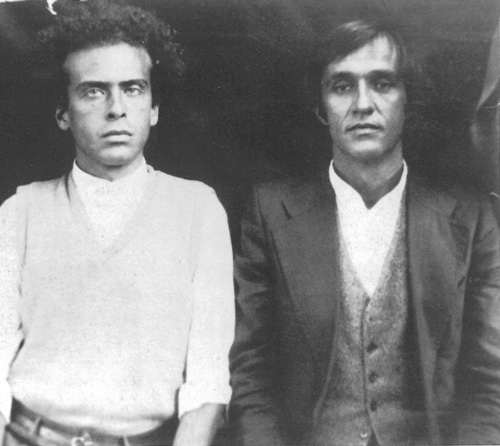
Alighiero Boetti and Francesco Clemente in Kabul in 1974. Courtesy of Alighiero Boetti Archive
In the summer he traveled widely in Guatemala. He returned with the series of photographs titled Guatemala, on the theme of the self and the other.
“Four photos, taken by four photographers who had come to the village festival, with their backdrops. Each photograph was printed in two copies, one being given to me, the other to my companion in the photo. Here in Italy, the foreigner in the photograph is the Guatemalan. Back there, in the photo posted on the wall of some house perched on one of the many volcanoes, I’m the foreigner.”
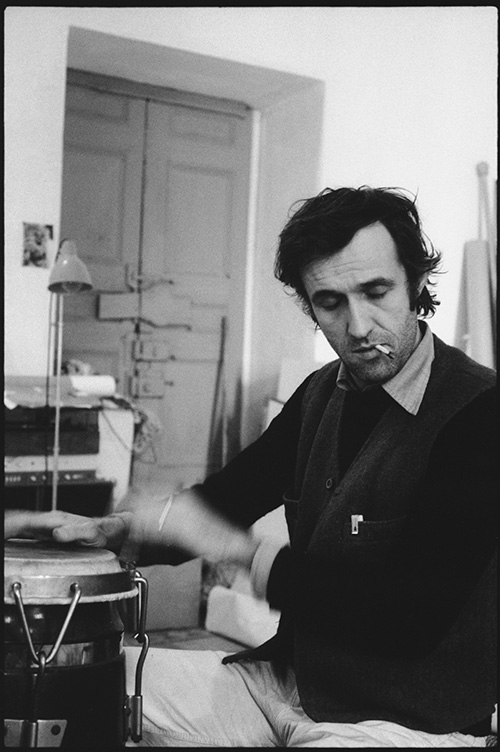
Alighiero Boetti in front of Estate’70 in his Roman studio, 1975, photo by Antonia Mulas
Following Cimento dell’armonia e dell’invenzione, Boetti produced a new type of work. It was executed on sheets of squared paper measuring 70 × 100 cm. The procedure consisted in blackening some of the squares using ballpoint (as he had done in Autodisporsi, the invitation to the Galleria Verna) on the basis of various arithmetical mechanisms: quantitative equivalences between addition and subtraction, alternation between odd and even, the infinite potential of multiplication, and periodic numbers, always by starting from elementary rules capable of generating endless invention.
“Number is the sole real entity that exists in the universe. Numbers are the sole entities that exist independently, in the sense that, if is true that by convention we put B after A, it is not by convention that we put 2 after 1, it is an overwhelming reality. For example, when I see a piece of quartz, I cannot see it as something dead. I see it as a formula of numbers that at a certain moment—perhaps because a drop falls and triggers some chemical procedure—grows and in an instant this perfect, crystalline hexagon appears, these perfectly interlocking molecules… Fibonacci teaches that the number of seeds in a sunflower develops in a precise series. Numbers are crazy entities, totally crazy…”.
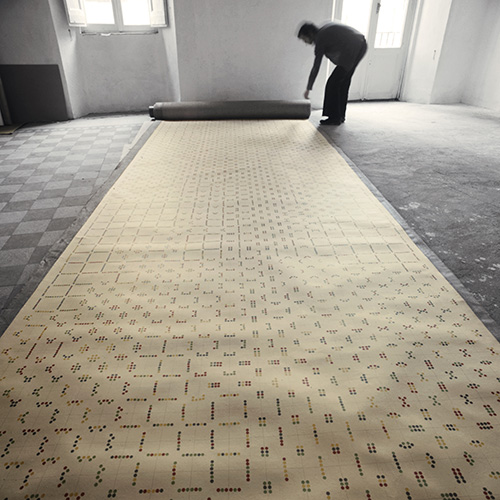
Boetti in his studio, 1974, photo Antonia Mulas
AB produced MILLE, Quadratura del Mille, TRENTUNO PER TRENTUNO PIÙ TRENTANOVE, Pari e dispari, Storia naturale della moltiplicazione, explaining:
“Unlike the logical and unambiguous progression of addition, multiplication proceeds by a twofold mental process: the growth within each form corresponds to an equivalent growth in the number of forms.”
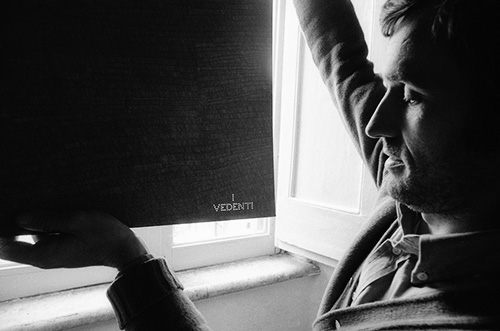
Alighiero Boetti, 1974, photo by Antonia Mulas
These works were all drawn in pencil by the artist and then gone over in black ballpoint by his assistant Mariangela De Gaetano. The first were exhibited the following year.
The works in embroidery were performed at the same time as the works in ballpoint. In fact, starting from Ordine e disordine, he used many phrases in both strands of his work, even in the course of the eighties, as was the case with Dare tempo al tempo and Ammazzare il tempo.
AB began to produce his first Calendari, by selecting from the 365 sheets of an ordinary astronomical calendar only those containing one or more numbers which could be used to compose the digits of the new year, a figure that determined the variable number of works he could produce. Greetings gifts created exclusively for his friends, they gave rise to a tradition which he continued until his last new year.
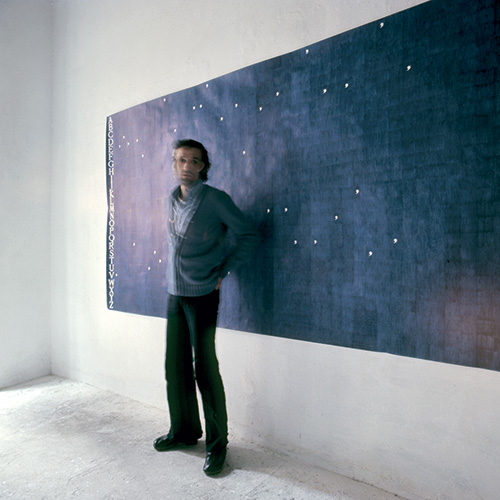
Alighiero Boetti, 1974, photo by Antonia Mulas
1975
At the start of the year Boetti took part in the group exhibition “24 ore su 24 ore” at the Galleria l’Attico run by Fabio Sargentini, exhibiting fifty drawings of Bombe ordigni origami e altro traced on extra strong paper, Estate 70 (the roll 20 meters long which he made in 1970) and some photographic enlargements of jokes about contemporary art clipped from newspapers and collected under the title of Riso (“Laughter”).
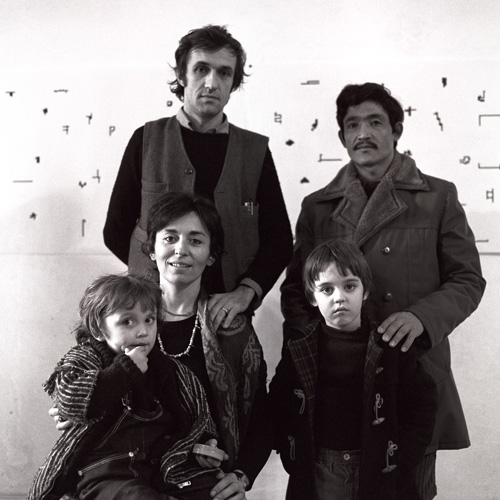
Alighiero Boetti with Annemarie Boetti, Agata, Matteo and Salman Ali, photo by Giorgio Colombo
In January and February he spent a whole month in New York with his wife, children and Salman Ali preparing his exhibition at the John Weber Gallery. They stayed in a loft at 10 Bleecker Street in the Tribeca district. He made friends with LeWitt, Weiner, Kossuth and Bochner. This was his second solo exhibition at the gallery. It opened on 8 February, with two large works on squared paper, Storia naturale della moltiplicazione and Trentuno per trentuno più trentanove. The exhibition was accompanied by an offprint of Tommaso Trini’s 1972 text, “Come non deragliare parlando di Alighiero Boetti.” Trini himself reviewed the exhibition in the June number of Data. The only American review, by Susan Heinemann in Artforum, was very critical.
Weber also organized a seminar for the artist at the Art School of the University of Hartford, where AB did some performances, including Due modi diversi di fare due cose diverse and Raddoppiare dimezzando. Attempts to persuade New York University Press to publish the Libro dei Fiumi in an English version proved fruitless.
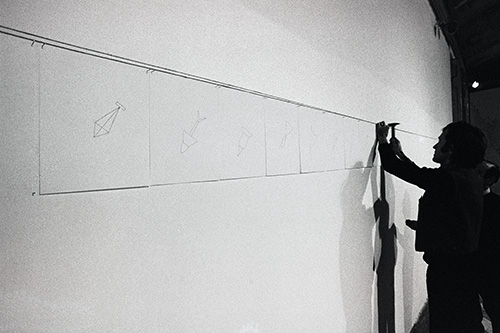
Alighiero Boetti prepares the 42 bombs, photo by Giorgio Colombo
On returning to Italy, Annemarie Sauzeau reflected on the experience of three years of America (the Galleria Weber, MoMA, universities and publishers) and wrote to their faithful friend John Weber: “Our conclusion after New York, for example after reading the reviews of exhibitions, is that Alighiero’s work and he himself are not understood in America. You are an exception because you have understood him, and that’s wonderful. I say this without indignation, it’s all for the best and things will change. I’m only referring to the current situation…”.
In May, Boetti had a solo exhibition at the Galleria Pasquale Trisorio in Naples: “boetti 1966.” It presented works from the Arte Povera period: Scala, Sedia, Mancorrente metri, PING PONG, Zig Zag, Mimetico, panels with words: CLINO, stiff upper lip and the triptych on cardboard 01.130 verde vagone, 1133 rosso adrianopoli, 2233 bleu positano.
In Munich, the Area Gallery presented a small solo show, “Zwei,” dealing exclusively with the theme of the double. The catalog was edited by Bruno Corà. The exhibition was repeated in November in the Florence venue, with the addition of a reading from the Koran, his favorite objet trouvé. He had bought a number of copies in Kabul to give as presents (at times with his name engraved in them). In June a solo exhibition at the Galleria Sperone in Rome again presented Storia naturale della molteplicazione.
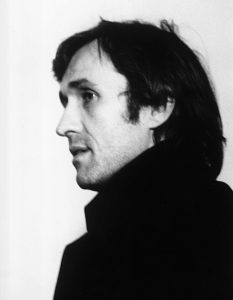
Alighiero Boetti at the Banco / Massimo Minini Gallery, 1975, photo by Ken Damy
In the summer Boetti traveled widely in Sudan and Ethiopia, sending back his postal works, which included Codice, Eritrea libera. He reached Harrar, as a tribute to Rimbaud in Abyssinia. Three years later he recalled:
“Rimbaud arrived in Africa by ship. That certainly was an adventure. In 1975, when I was in Ethiopia, a boy asked me in English if wanted to see Rimbaud’s house. I asked who he was. ‘Ah,’ he said, ‘a person who gave French lessons.’ I realize the imagination now offers nothing like that ship that carried people towards new horizons.”
In October at the 13th São Paulo Bienal in Brazil, he was represented by Storia naturale della moltiplicazione. It was chosen by the commissioner for the Italian participation, Bruno Mantura.
In September he intensified the reordering, begun in ’73 with Rinaldo Rossi, of the profusion of his drawings, photographs, performances and ideas, to complete the portfolio Insicuro noncurante. It was presented on 23 October at the Saman Gallery in Genoa. A drawing made up of dashes and crosses on squared paper, originally titled I pini non crescono in un giorno, underwent further development. In the folder Insicuro noncurante it was inserted with the outline doubled and given the new title Verificando il dunque e il poi se ne andò piano piano verso il canto di una pineta (a quotation from Metastasio). In 1979, transferred to fabric embroidered in white on white, the drawing became L’albero delle ore. Boetti explained the triangular form of the composition in these words:
“The bell tower of the church of Santa Maria in Trastevere sounds the hours and quarter hours with two different notes. So at every quarter hour you hear at the very least one stroke (at 1 o’clock) up to a maximum of fifteen (at 12:15). This progression, transcribed into two signs like two notes, forms a double triangle, of day and night.”
This year there appeared three small drawings: Gradine, a human outline slumped across some steps, Giogare and San Patrick, which were subsequently integrated into two large drawings on light paper, both titled Collo rotto braccia lunghe (1976).
“I did that work thinking about someone who was able to turn his neck 360 degrees—a broken neck obviously—and then I thought about the blind person interviewed by Diderot on the problem of blindness. Diderot was obsessed by this problem, he’d done a whole book about the blind. He interviewed them, asked them what a mirror was and so on. He asked one if would like to see the moon and he replied no, but he’d like to touch it, to have hands so long he could touch it…, the desire to touch from afar…”.
The Boetti completed Classifying, the thousand longest rivers in the world. While continuing their search for a publisher, AB prepared to transfer the list to fabric with a view to having one or more tapestries embroidered in Kabul with the title I mille fiumi più lunghi del mondo. In preparation, he designed three small test pieces and had them made up over the same years. They showed the names and lengths of the rivers written in “pixels,” which would be embroidered in three color variants. In the two large definitive versions, begun in ’76, the entire list of rivers unfolds in horizontal lines about five meters long, arranged in descending order (from the longest, the Nile-Kagera, down to the thousandth, the Agusan).
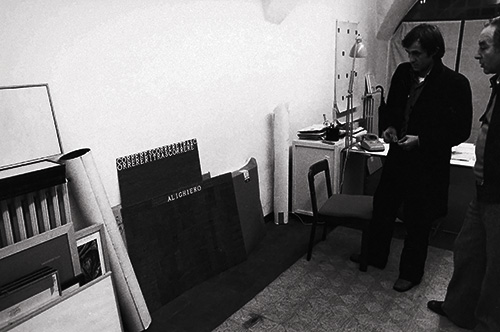
Alighiero Boetti with some of his works on deposit at the Galleria Banco / Massimo Mini, Brescia, photo by Ken Damy
Through Francesco Clemente, AB met Giovan Battista Salerno, a young art critic with whom he formed a strong and enduring intellectual affinity. Between his other friendships that with Mario Schifano, whom he had met in his early years in Rome, was strengthened. Of their relationship, Salerno observes: “I believe that Alighiero respected a certain eclectic freedom in Schifano, the fact that he went in for cycling and Polaroid photos! Eclectic, not amateurishly but as an encyclopedic way of drawing on practically everything, from movies to parties or bicycle design. I think it brought them close together.”
1976
The magazine Studio International55 devoted the whole of its January–February issue to Italy. Titled Italian Art Now, it had an introductory essay by Achille Bonito Oliva (“Process, Concept and Behavior in Italian Art”) and contributions by Germano Celant, Annemarie Sauzeau Boetti, Barbara Radice, Caroline Tisdall and Luca Venturi. The artists chosen were presented with illustrated interviews or with four pages edited directly by each. Of Boetti’s pages, the first two (a photo and eight small drawings) were figures from the Insicuro noncurante portfolio.
The third page was titled “Classifying the Thousand Longest Rivers in the World, 1970–1974, a book by annemarie and alighiero boetti” and was a typed list of the one thousand names of rivers in order of decreasing length, with some corrections in pen. Finally, on the fourth page appeared a photograph of Estate 70, described as “summer 1970, a roll of paper 20 × 2 meters, self-adhesive dots in 4 colors.”
The portfolio Insicuro noncurante was presented in March at the Studio Marconi of Milan and in May at the Galleria D’Alessandro-Ferrante in Rome. Boetti then suggested that Giovan Battista Salerno should start work on an informative manual about the portfolio. Of the project, Salerno wrote: “From the start we planned to do an ‘informative manual’ together. What he hoped was to have a brief text ‘for each work’ which would be neither a critical reading nor just journalism nor yet information pure and simple, but all these things together. It should help its viewers to lose a little less time as they looked by dwelling on the aesthetic or purely formal side of the work. Because though this part was present and in fact striking, there were other things that at times suddenly clicked in the viewer’s mind but were not always so obvious, certain devices or codes…”.
Salerno also wrote the text presenting the portfolio in the bulletin Studio Marconi n° 5.
In October the exhibition “Prospect Retrospect, Europa 1946–1976” was held at the Kunsthalle in Düsseldorf. It was curated by Benjamin H.D. Buchloh, Rudy Fuchs, Conrad Fisher, John Matheson and Hans Strelow. Boetti was represented by recent works on squared paper.
A few days after Düsseldorf, the solo exhibition “quadrare diagonando. alighiero e boetti” opened in Brescia at Massimo Maninni’s Galleria Banco. “Quadrare diagonando” referred to a small drawing (which had already appeared in the portfolio Insicuro noncurante) printed on the invitation. It also appeared in one of the works on display among the thirty-six graphic symbols of Gli anni della mia vita.
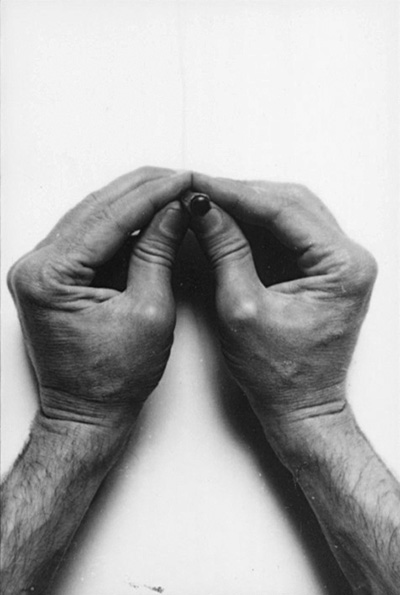
Two hands a pencil, photo by Gianfranco Gorgoni
The Brescia exhibition marked an important stage in the development of Boetti’s art, presenting works which revealed an increasing complexity. This appeared in the parallel typologies of La notte da luce alla notte, a ballpoint pen from ’75, La metà e il doppio, a drawing in India ink on squared paper, and an Autodisporsi, both from ’74. On display was Prima e quarta di copertina, one of his first montages with tracings of cover designs. They looked ahead to the large series of images based on popular magazines, a recurrent theme in the eighties. Finally he designed a poster for the gallery using a sequence of black and white photos taken by Gianfranco Gorgoni in ’75, in which we see the arms and hands of the artist as he traces a pencil line on a sheet of paper. The image, subsequently titled Due mani, una matita, was also described by the artist himself as “Two limbs and a pencil.” Another similar shot by Gorgoni immediately became a pencil drawing, Senza titolo, which was the matrix for the whole sequence of works on paper Tra sé e sé.
1977
On 16 February, the Marlborough Gallery in Rome presented “Alighiero e Boetti”: it exhibited Niente da vedere niente da nascondere (1969); 720 lettere dall’Afghanistan (1973–1974); a work in biro, Segno e disegno; Collo rotto braccia lunghe (1976) and the ink version of Gary Gilmore (1977). The artist’s attention was captured by violent deaths in the social context of the so-called “anni di piombo”: AB traced the outlines of various corpses among which Pasolini’s; also Gary Gilmore, who was under death sentence in the USA but asked for immediate execution, moved him particularly.
“For three days, using my left hand, I wrote out his interview, his last moments, when they forcibly put the hood on him, because they couldn’t look at him any more. He was my age.”
On the same occasion, at the Marlborough, he presented Orologio annuale (a GEM Montebello limited edition wristwatch issued in 200 numbered examples). He also began another ritual, rather like the Calendars begun in 1974, a new annual appointment with Contatore, a “time counter.”
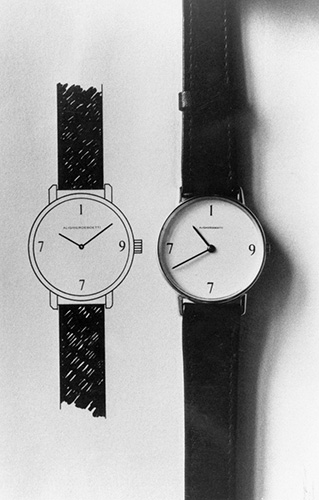
Annual Clock with preparatory drawing, photo by Giorgio Colombo
Between February and April, the Galerie Annemarie Verna in Zurich presented a solo exhibition divided into two parts. The invitation was a page in black and white with a detail from Gli anni della mia vita dating from ’75. The works exhibited in the first phase were the set of panels of the Insicuro noncurante portfolio and an unpublished drawing Vista dallo studio (a composition that eventually became Tracce del racconto in the group exhibition at San Remo the following December). The second part of the exhibition presented, on its own, the work in ballpoint pen, I sei sensi, on eleven sheets of blue paper.
At the same time, in Florence, the Galleria La Piramide Multimedia presented works by AB essentially on squared paper, including Autodisporsi and Alternando da uno a cento e viceversa. The artist commented on them in these words:
“I called up a boy in Milan and explained a system to him: take a hundred squares made up of a hundred smaller squares each and alternate one black square with two white squares and so on. He did this, sent me the sheet and the work was ended and at the same time begun. In this way I eliminated the problem of ‘quality’: whether this work is done by me, by you, by Picasso or by Ingres doesn’t matter. It’s the leveling of quality that interests me.”
The artist also arranged for an embroidered version to be made of the work. This was one of the phases of this arithmetical theme, and not the last.
AB was working with the designer Guido Fuga on the project for the Aerei triptych.
“There is a firm in Turin which sells a cheap four color print in strips of an exotic landscape. I’d like to do something similar. I want to get an assistant to draw a thousand airplanes on a sheet of paper with a dark blue ground, the color used for the sky in nativity crèches. The planes accurately drawn in all different perspectives, from different angles, so they look really stunning. It has to be explosive!”
On 31 March, he had a solo exhibition at the Galleria L’Ariete in Milan. The works included the two recent drawings Gary Gilmore e Collo rotto braccia lunghe, Alternando da uno a cento e viceversa (drawing on squared paper) and a postal work. In the adjacent room, Ariete-Grafica presented: Orologio annuale and the “edition” of two small embroideries (Per nuovi desideri and Udire tra le parole) made specially for the gallery.
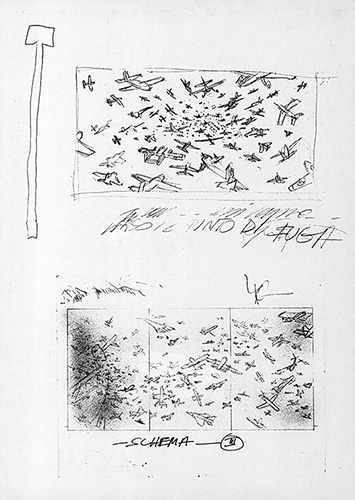
Preparatory drawings Aerei di Fuga
It should be noted that the term “edition” has a specific meaning in relation to AB: it is always a sequence of unique examples, which he himself called “single multiples” because they were executed by hand and inevitably with different features, from the colors to the single “hands.” This was true not only of the embroi- deries but also other types of works.
The Galleria L’Ariete also exhibited some examples of the poster Faccine printed in offset. The magazine Data (number 26) published the image full page with this caption: “Poster measuring 140 × 100 cm, published by the Multhipla in Milan, and printed in 5000 copies in black and white.
Some of these posters were then given to be colored to the children at the Casa del Sole school, and then exhibited in the gallery. The black and white posters on sale in the gallery cost 3000 liras, those colored by the children cost 5000 liras.” Other copies of the poster were then given to friends and collectors with the invitation to color the drawing.
In April, on AB’s eleventh visit to Afghanistan, he was accompanied for a month by his seven-year-old son Matteo.
On his return in May, he participated in the Turin group exhibition “Arte in Italia 1960–1977” curated by Barilli, Del Guercio, Menna, at the Galleria Civica d’Arte Moderna. He displayed Cimento dell’armonia e dell’invenzione. The work was not recent but perfectly aligned with the theme of the section curated by Renato Barilli, titled “From the Work to Involvement,” from the neo-Dada legacy down to Arte Povera and the beginnings of Italian conceptualism. Barilli wrote: “Boetti has already explored certain serial and combinatorial possibilities. However unlike the serial works of minimalist inspiration, his always entail intervention by others.”
AB continued to produce works in ballpoint, in sequences distributed on a number of sheets of paper (as in Seguire il filo del discorso, which was done on five sheets), as well as designing new medium-sized embroideries for Kabul (measuring about 50 × 60 cm) bearing long, poetic inscriptions: Sandro Penna io vivere vorrei addormentato entro il dolce rumore della vita, Verificando il dunque e il poi se ne andò piano piano piano piano verso il canto di una pineta (a quote from Metastasio) or Ordine e disordine, done in white on a black ground.
On 7 October, at the Centre d’Art Contemporain in Geneva, the exhibition “Alighiero e Boetti” presented a Storia naturale della moltiplicazione on eleven panels, the sequence of telegrams Serie di merli disposti ad intervalli regolari lungo gli spalti di una muraglia, the drawing of Gli anni della mia vita and a black and white embroidery Segno e disegno, with the inscription unfolding in a spiral and ending with the O in the middle.
On 29 November, the Galleria Il Collezionista in Rome presented the triptych Aerei. The exhibition’s exact title was “Alighiero Boetti in collaboration with Guido Fuga designer.” The opening of the review by Maurizio di Puolo express the general amazement that the work elicited: “Hundreds of airplanes circling in three great blue skies. The gallery is empty and, in a brilliantly lit room, there’s only this absurd triptych, a blast of crazed brilliance. There’s no title and the authors are doubled, or rather trebled: Alighiero, Boetti and Fuga.”
The following year J.C. Ammann asked AB about the meaning of the work Aerei. He replied:
“I think I did it because today everything strikes me as simultaneous and at the same time superficial.”
In December, at the group exhibition “La traccia del racconto, 21 artisti italiani contemporanei” held in the Villa Comunale Ormond in Sanremo, AB presented Undici fogli Afgano-Etruschi (Le parole che uccidono) from 1976 and a second version of the drawing exhib- ited in Zurich in February under the title Vista dallo studio (from this time both works were titled Tracce del racconto). In the catalog Corinna Ferrari wrote of AB’s attitude to the vocabulary of art. “He seeks to counter habit with a subtle concern, an unprejudiced intuition, capable of reactivating the appearances of signs, and of grasping, through an uncommon logical system, the transitions, the openings by which signs create links with each other or change their register. I believe Alighiero’s partiality for maps, geographic and geometrical plates, and diagrams reflects the desire to identify privileged places in which to perform these semantic shifts.”
1978
On 5 March, the Basel Kunsthalle presented the first anthological exhibition of Boetti’s work, curated by Jean-Christophe Ammann. Almost sixty works were on display, including the never previously exhibited set of Viaggi postali, completed by the Dossier postale which constituted its progressive “radiography”; some works of large dimensions such as Cimento dell’armonia e dell’invenzione, made up of twenty-five pieces (1969), Estate 70, I sei sensi, a polyptcyh of eleven panels (1973), 720 lettere dall’Afghanistan, the large Mappa (1971–73), Ordine e disordine, consisting of a hundred embroideries (1973), and I Vedenti, a set of five embroideries.
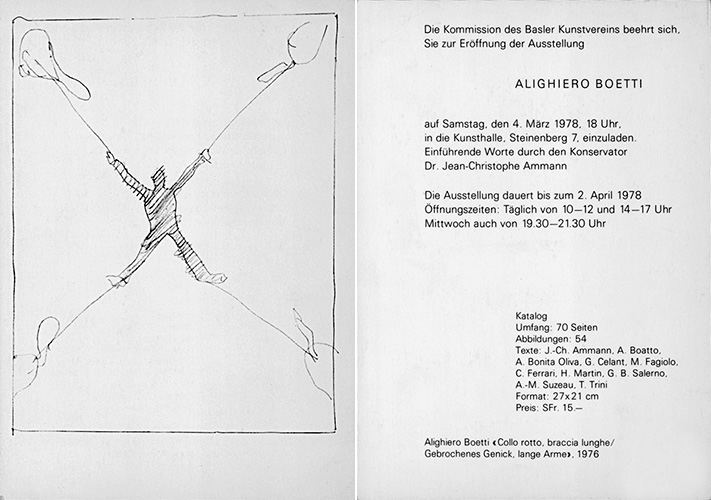
Invitation to the Kunsthalle Basel exhibition, 1978
In addition it showed recent works presented the previous season in Italy, such as Collo rotto e braccia lunghe, Gary Gilmore, Aerei, il Libro dei Fiumi (which the public could leaf through) and a large new embroidery Titoli. On that occasion Emidio Greco shot “Niente da vedere niente da nascondere,” still a fundamental document and film about the artist.
In March and May AB took part in the De Foscherari group exhibition “Le figure del tempo,” with works in two out of the three sections (Lampada annuale and Cimento dell’armonia e dell’invenzione).
On 6 May, the Galleria Mario Diacono in Bologna again presented Collo rotto, braccia lunghe e Gary Gilmore. Diacono wrote and published a pamphlet with an illuminating analysis of the concept of “the left hand” in Boetti’s work, in which he coined the neologism sinistritudine (“leftishness”) to indicate the gap between idea and execution, “the left hand of being…, the hypersignifier by which the “e” (and) in Boetti’s name has doubled/copied social meanings and references,” to the point where in other works it had become “that team of craft workers who over the years have materially executed some of the works.”
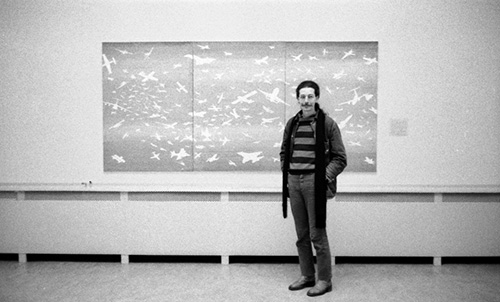
Basel, Guido Fuga in front of the Aerei, 1978
On 11 May, the Galleria Liverani in Rome opened “Pas de deux,” a man/woman exhibition curated by Annemarie Sauzeau Boetti and Giovan Battista Salerno. AB, in duet with Berty Skuber, presented Regno animale, the first composition of the Tra sé e sé type of work. In 1981, for the exhibition at the Galleria Chantal Crousel, he wrote:
“A straight line joins the pencil of Alighiero to the pencil of Boetti. A kind of Ping Pong. Animals, even a stone, and to avoid privileges even a moped (mine), follow their own path, or rather orbit. It is the quietest work I have ever done. These animals move across the sheet bearing in their images the memory of millions and millions of their predecessors and they evoke time, ancient time, slow, anonymous, identical, unmoving, unchanging.”
The book Classifying the thousand longest rivers in the world, finally published and presented in Basel, was promoted in various galleries, for example at the Galerie Paul Maenz in Cologne on 31 May and in Rome at Il Cortile on 13 June.
On 2 July, AB exhibited Dodici forme a partire dal 10 giugno 1967 at the 39th Venice Biennale, “Sei stazioni per Arte natura/La natura dell’arte” curated by J.-C. Ammann, A. Bonito Oliva, A. Del Guercio and F. Menna.
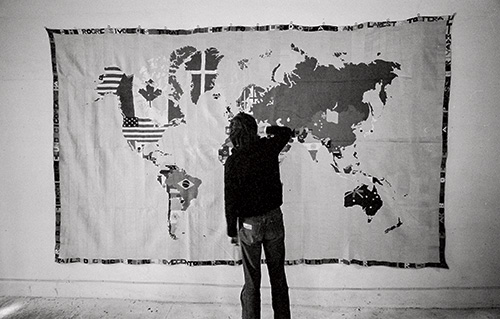
Alighiero Boetti, Kunsthalle Basel, 1978, photo by Gianfranco Gorgoni
A review of the Biennale in Data presented a highly significant survey of AB’s conceptual work, starting from the Arte Povera years and including the 1967 Manifesto, the Dossier postale (1969–1970), a Lavoro postale sent from Kabul in 1971, down to the most recent ink drawing Gli anni della mia vita, 1976.
This year AB devoted himself increasingly to his private works on paper in mixed media (colored inks, pochoir, collage, frottage, massage and embossing), including lettering in pencil with his left hand, creating a sort of diary account of his practices.
“What always speaks in silence is the body. So I wrote with two hands, moving from the center outwards to the greatest possible extension of my arms. I measured my unit of extension as 1.83 meters. That was March 1970 in Turin.”70 “August 1978 in Rome, Alighiero and Boetti prepare some drawings, collages and/or others before undertaking some big new works. I am particularly alone and I found a precise analogy to my commas, as they’re called in English (I like the term more than virgole) in Mallarmé… I am using material from the past, detritus, leftovers, catalogs… The basis is pack ice, which I believe represents my brain at this time.”
Or again, on the photograph of himself with his fist closed and fist open, dating from 1968 and titled San Bernardino:
“Ten years ago at San Bernardino-Vernazza photographed by Robert Cagnoli whom I’ve lost touch with for some years now—I don’t remember the color of the sweater certainly I haven’t got it any more—the photo served as a postcard-invitation to my first exhibition at the Sperone gallery…”.
On 14 December, he had a solo exhibition at the Galleria Stein. The invitation contained a number of phrases arranged in squares on squared paper. This was also the preparatory phase of all of the embroideries using letters which were later sewn in Afghanistan. AB exhibited only embroideries, including Ordine e disordine, made up of a hundred elements, the large embroidery Titoli and a black and white Segno e disegno.
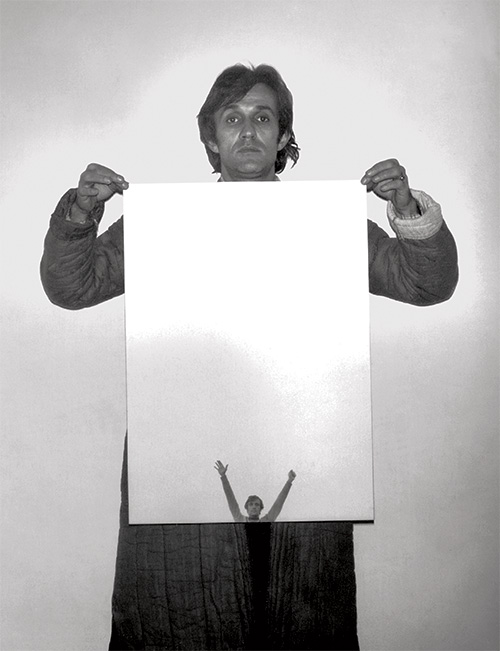
Alighiero Boetti, 1978, photo by Paolo Mussat Sartor
1979
1979 was a year of mourning and personal instability. It began with the loss of his mother, Adelina Marchisio, on 2 March and ended with another loss, of the Afghanistan he loved, invaded by Soviet troops in December. Troubled by political developments in Kabul, as early as 17 February he sent himself in Rome a letter bearing a stamp with the new all red national flag. On his return he examined the possibility of now having his tapestries embroidered in Italy or Morocco, but nothing came of it. Meanwhile he arranged for the sewing of the large white embroidery titled Albero delle ore.
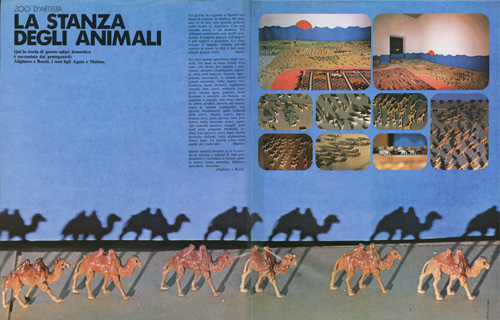
Zoo, by Casa Vogue (release date: January 1980)
The One Hotel in Kabul had been closed for sometime. Dastaghir, the ex-manager had more or less disappeared. AB’s health deteriorated, as did his mood.
He participated without enthusiasm in numerous group exhibitions in Germany, the United States and at public galleries in Milan and Bologna, which surveyed conceptual art internationally.
“La festa dell’immaginario visivo,” curated by Tommaso Trini, opened on 5 May at Gavirate (Varese). This was a solo exhibition that deeply interested the artist and partly brought him out of his depression. On this occasion AB further developed what he called his “personal collective” works, done in collaboration with many ONONIMI (anonymous/homonyms).
As earlier for his solo exhibition at the Galleria L’Ariete, he got some local schoolchildren to color in the Faccine, reprinted in a new and smaller edition and partly already colored (unlike the earlier poster in ’77). Mayor Oldrini sent out a covering letter in January 1981 with the colored posters. He explained: “I am sending you 26 posters colored by the children in primary schools at Gavirate, Voltorre and Oltrona, on the occasion of the exhibition held at the cloister of Voltorre in 1979.”
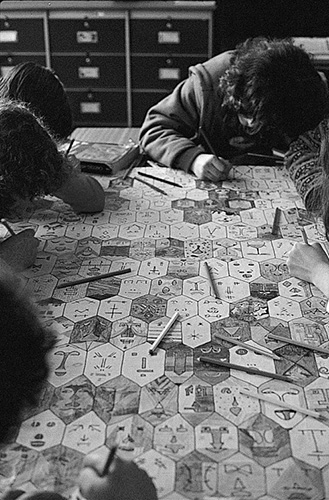
Gavirate (Varese), “La festa dell’immaginario visivo”
The posters colored by the children had been exhibited in the portico of the cloister, together with the two original sheets of Faccine, previously colored by the artist and his daughter Agata on the 1977 offset print. In the exhibition the adult residents of the town were also involved in drawing the graphics of Alternando da uno a cento e viceversa. The letter they received from AB stated:
“You are one of a hundred citizens of Gavirate who have received this envelope. It contains a printed sheet of paper that represents the hundredth part of a big drawing… I hope you will decide to participate in this community work, which is also a project to be created in the future as a mosaic, or a tapestry to be woven, or the paving of a public area in Gavirate… I look forward to taking part together in the ‘festival of visual imagery’ and send you my cordial best wishes.”
Finally, among many other works, he exhibited Il Muro for the first time. This was a work begun in ’73, a collection of private “icons” subject to continuous additions and alterations.
“All these things used to hang on the wall of my home in Rome. They have been removed and hung up here in Gavirate. A photo of my son Matteo in Kabul… A piece of lace which spells out 1970, which, by a happy coincidence, has 49 letters, the square of 7… Classifications and hierarchies of rivers, seas, mountains and/or other things. Telegrams for blind people, only in America… Printed fabrics, a Persian silk-screen print,the postcard sent in ’68 with the twins A and B… The work of a Moroccan tailor, a portrait from ’69 done by Salvo, and one of his small oils on board, a drawing by Chia, by Tirelli, etc. etc. The desire to level and unify these forms, these different ways of doing things…”.
In September he spent his usual autumn period in Afghanistan, commissioning numerous embroideries, including some of the Mappe. This was to be his last visit and the works had to be air-freighted, in some cases arriving after many mishaps.
Before winter, working in his studio with his children Agata and Matteo, he prepared the “Animal Park” or Zoo, an easy-going, cheerful work, both orderly and disorderly. It was luckily captured by the photographer Giorgio Colombo and published in Casa Vogue in January 1980 with a description by AB himself:
“These animals bear within themselves the memory of millions and millions of their predecessors and remember time, ancient, slow, anonymous, identical, unmoving, unchanging.”
In autumn there were more exhibitions. In October, at the Galleria Plura in Milan, he presented an “edition” in forty copies and five artist’s proof copies of Nove Quadrati: nine watercolors fully painted by hand on watermarked paper specially produced by Rinaldo Rossi. Each sheet was therefore unique.
On 30 November, at Castello Colonna in Genazzano, there was the group exhibition “Le stanze” curated by Achille Bonito Oliva. AB showed two conceptual works from his Arte Povera period: Niente da vedere niente da nascondere from ’69, an impressive sculpture in iron and glass, and 1970, a delicate composition in filet lace. Both works were based on the same square format.
On 22 December, at the Stedelijk Museum in Amsterdam, at the survey of work by Gary Schum, the pioneer “video-curator,” AB presented a video documenting his two-handed writing performance, Giovediventiquattrosettembremillenovecentosettanta, shot by Gary Schum at the exhibition “Identifications 70.” The exhibition was repeated in 1980 in Rotterdam, Cologne, Ghent, Vancouver and Toronto.
This year, starting from the mirrored structure named Tra sé e sé, which began with Regno animale in 1978, AB started a sequence of works on paper using mixed media, collage, calligraphy and other techniques. The result was Regno musicale (dedicated to his mother), Regno delle carte and his composition which incorporated a “checkerboard” Alternando da uno a cento e viceversa, which contains the following comment, written in pencil with his left hand:
“AEB wrote thinking about a large pavement in an open, public place walking on slate and travertine—mathematical and fantastical—order and disorder with the eternal alternation between aeb and bea, a sort of ping-pong…”.
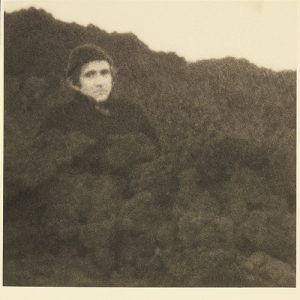
Alighiero Boetti on Mount Etna, Sicily, photo by Annemarie Sauzeau
Together with the embroideries, the new works in ballpoint pen were conceived, developed and prepared by AB but always drawn by different hands. They were new phrases and compositions which, in addition to blue or black, used other ballpoint colors such as green and red: Sragionare in lungo e in largo, Talvolta luna talvolta sole, Uno nove sette nove, Normale Anormale. The same color variations (four industrial colors) were applied simultaneously to Aerei, with the hatching of the ground filled in with ballpoint pen.
In the last days of December, with the Soviet tanks occupying Kabul, AB spent a melancholy vacation with his family in a snow-covered Sicily.
1980
On 23 February, at the solo exhibition at the Salvatore Ala Gallery in New York, AB presented some essential works from the seventies, still unknown in the United States. They included 720 lettere dall’Afghanistan, with the related book of bound drawings (1973–1974), a diptych in blue ballpoint pen Mettere al mondo il mondo (1974), and the triptych Aerei (1977). He also repeated in a large format the concept of Mimetico, his readymade of 1966–1967, exhibiting one of the few examples produced in 1980–1981.
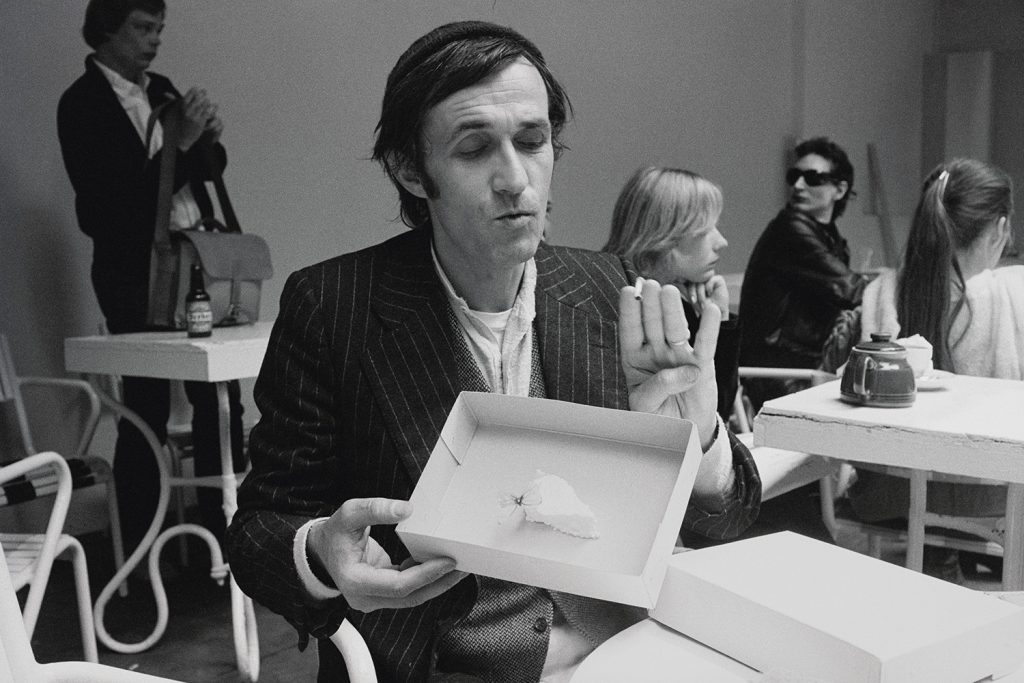
Alighiero Boetti with the butterfly of “Io che prendo il sole a Torino 19 Gennaio 1969” – Venice Biennale 1980, photo by Giorgio Colombo
Spring passed emptily without his usual stay in Kabul. AB participated from a distance in two important group exhibitions, without attending the openings. On 8 May, the Hayward Gallery in London opened the group exhibition “Pier+Ocean, Construction in the Art of the Seventies,” curated by G. von Graevenitz. It was a very ambitious scholarly project that traced a history of Constructivism and concept of space from Mondrian.
The exhibition then ran from 13 July to 8 September at the Rijksmuseum in the Netherlands. After the optimism of the sixties, writes the curator, “The space of seventies art is an open space, to which the individual artwork relates as the pier does to the ocean.” Boetti was placed in the section “Opportunity System Endlessness,” with Baldessari, Darboven, On Kawara, LeWitt, Opalka and others, represented by the book Classifying the thousand longest rivers in the world and a Lavoro postale of 1974 in eight elements (four panels of envelopes with Italian stamps and four of drawings). From the title of this exhibition AB drew the inspiration for Molo o Pier Piet, a ballpoint drawing that plays on the gestalt effect of solid (pier) and void (ocean) and the pun on “pier” and “piet” (in homage to Piet Mondrian).
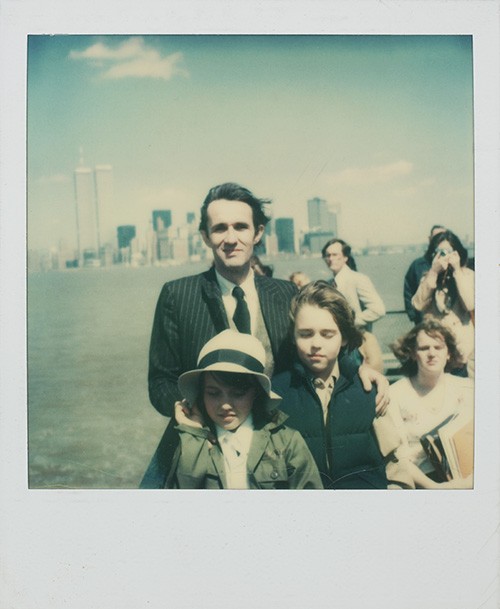
New York, Alighiero Boetti with his sons, Matteo and Agata
On 17 May, the group exhibition “Ut pictura poesis” opened at the Pinacoteca Comunale in Ravenna. Curated by Mirella Bandini and Italo Mussa it dealt with the theme of writing and the drawing of word. AB exhibited three works related to language, two of them from of the Arte Povera period, the two diptychs Rosso Gilera Rosso Guzzi of ’71 and 11 luglio 2023 16 dicembre 2040 of 1969 and a third belonging to his later conceptual output, Mettere al mondo il mondo, a diptych in blue ballpoint with a code to its interpretation which combined letters and commas.
The subsequent exhibitions focused on his latest works and in particular the years of the crucial transition from Arte Povera to pure conceptualism.
In June AB was invited to the 40th Venice Biennale. He exhibited the sculpture Io che prendo il sole a Torino il 19 gennaio 1969, his performance video shot by Gary Schum and presented at “Identifications” in 1970, and the large Mappa of 1971–1973.
A few days later, on 27 June, he went to Tokyo for a solo exhibition at the Art Agency, the leading Japanese gallery, which at that time had placed its television network at the service of the international avant-garde. In the previous months he had sent from Italy a series of postal parcels, 295 in all, based on an exponential increase. They were mounted in the gallery as a Lavoro postale produced specifically for this exhibition. They consisted of sixteen panels of envelopes and the drawings they contained. The series of stamps, envelopes and drawings rose in the last panel to sixty-four envelopes (8 × 8), the whole work consisting in 204 envelopes plus the 204 drawings inside them.
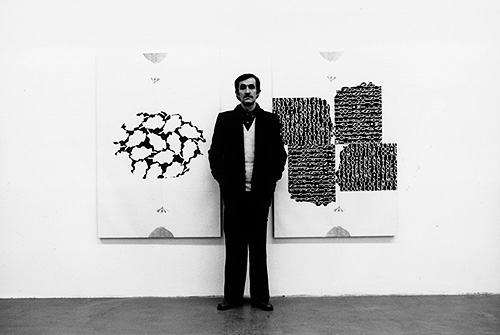
Alighiero Boetti to the solo exhibition at the Banco / Massimo Minini gallery, Brescia 1980, photo by Giorgio Colombo
“The vital element of the work is the existence of order and disorder. There is an irony in order represented by the envelopes, with the graphic obliterations by the postal system, the marks left by rain when being passed from hand to hand… It represents an order invaded by the disorder of everyday life. This element of chance permeates the whole work.”
In addition to this monumental composition he exhibited an embroidery made up of one hundred pieces, all different, of the same one phrase Ammazzare il tempo.
“I’m not a painter, I’m an artist, so I use technical non-pictorial techniques. For example, in my postal works I use stamps for their colors and for the same reason I use threads in embroidery…. I have a great affinity for systems: the orderly system of human life in contrast with the disorder of nature is a contradiction that I always explore in my work.”
Apart from the Venice and Tokyo exhibitions, AB was rarely present at his exhibitions because his health was poor. His love of artificial paradises had reached the point where it strongly affected his life. His forced exclusion from Afghanistan was also related to reflections on the social context in Italy, in the ominous period of the late seventies. In his works on paper the images of death, massacres and war multiplied, taken from events reported in the papers.
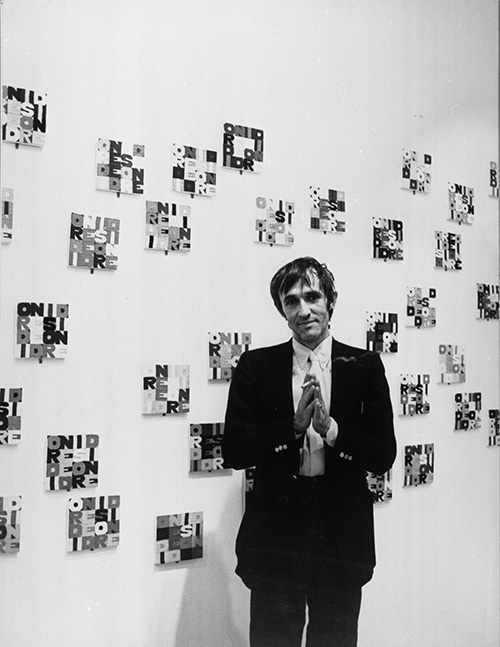
Alighiero Boetti in “Identité italienne” at the Center Georges Pompidou in Paris 1980, photo by Nanda Lanfranco
On 16 December 1980, he turned forty, with a certain melancholy, and yet the same day he enthusiastically began to work regularly for Il Manifesto, a daily. Every day Boetti contributed a signed image, symbol or drawing in black and white. He found black and white rotogravure paper and the serial medium fostered his natural gift for producing non-works, as he had tried to do with Gemelli and Manifesto in ’68. So on Tuesday, 16 December, the drawing Ordine Disordine appeared in the paper with a joint editorial by M. Notorianni and G.B. Salerno. The next day the drawing was Afghanistan. He contributed every day until Saturday, 24 April 1981. His last drawing presented four sentences set in a square. They read: “do a square,” “redo a square,” “redo it again,” “quit do squares.” On 20 December, at Massimo Minini’s Galleria Banco in Brescia he had a solo exhibition, “La natura, una faccenda ottusa.” The title (i.e. “Nature is a dull affair”) used the words of the English mathematician and philosopher A.N. Whitehead, the declared master of Gilles Deleuze. This concept underpinned a profound reflection by the artist on the disorderly proliferation of the various “realms.”
“Beginning in 1980 there is a series of my works on the theme of Nature is a dull affair. In them I wanted to present nature as without form or color, only a senseless hurrying towards life… It is the mental human gaze that seeks to find colors, scents, beauties…”.
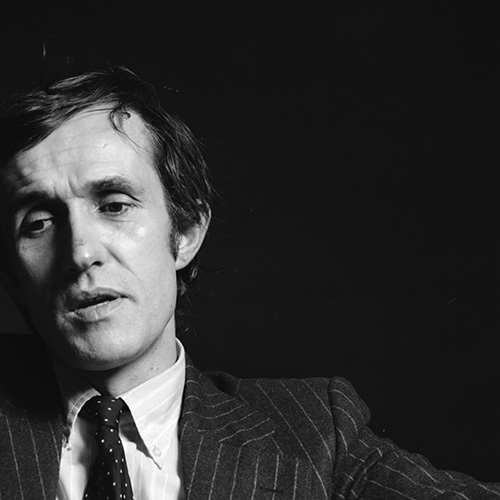
Alighiero Boetti, 1980, photo by Antonia Mulas
The specular structure Tra sé e sé formed the basis of four new colored compositions in mixed media (La natura una faccenda ottusa), as well as two other works in black and white: Le quattro operazioni and Afghanistan, where we read between the “twin poles”:
“Afghanistan, beloved country, where eighty-five thousand Russian soldiers who entered in December ’79 hold power. Alighiero and Boetti in the last sunny days of October in the year 1980 absent for more than a year.”
1981
On 14 February, the group exhibition “Linee della ricerca artistica in italia 1960–1980” was held at the Palazzo delle Esposizioni in Rome. AB was represented by a Mimetico and a work on paper from ’75, Untitled, which bore a long inscription written with his left hand.
On 21 February, he had his first exhibition in France: an anthological solo in the gallery of Chantal Crousel in Paris, “Alighiero and Boetti 1965–1981.” AB personally wrote a text in French Notes pour une exposition, an annotated list of the works exhibited: L’albero delle ore (“Un double triangle, du jour et de la nuit. L’arbre des heures”), a Mimetico (“Mimétisme-perte d’identité; mimétique – paysage pass-partout”), and the ballpoint work Seguire il filo del discorso (“Cinq feuilles, cinq mots, cinq personnes qui ont rempli une feuille au stylo à bille, chacun la sienne, chacun à sa manière, laissant en blanc lettres et virgules. En allant de gauche à droite et suivant les coordonnées [double lecture, horizontale et verticale] vous lirez ‘seguire il filo del discorso.’. Une façon de transformer les mots en figures”).
He also exhibited Storia naturale della moltiplicazione (1975) in eleven sheets, the relief in cast iron 1970, and finally a Mappa. The times did not seem ready for success in France; the Centre Georges Pompidou considered purchasing Mappa but decided against it.
In spring AB rested in the countryside, then he left his family to visit the north, particularly Turin and Milan, where he found support among his dealer friends, including Franz Palludetto and Massimo Minini. Some projects were postponed, included the exhibition planned for 20 November in Zurich at the Annemarie Verna Galerie, which was very helpful in postponing the exhibition.
On 22 May, he had an exhibition at the Galleria Franz Paludetto in Turin which consisted only of embroideries, in particular Ammazzare il tempo, made up of forty-nine elements, from which the exhibition took its title.
Despite poor health, on 25 June he returned to Paris for a particularly significant group exhibition, organized by the Centre Pompidou and curated by Germano Celant: “Identité italienne, l’art en Italie depuis 1959.” AB was photographed at the opening by Nanda Lanfranco and he exhibited two important large works: Ordine e disordine, the noted composition of a hundred embroideries, and a Lavoro postale of 1972, consisting of 492 envelopes based on a combinatorial pattern of Italian stamps.
On 10 December, the solo exhibition “Alighiero and Boetti,” its contents largely agreed between Boetti and Massimo Minini, was held at the Galleria Franz Paludetto/LP in Turin. It consisted of works on paper, all based on the Tra sé e sé structure. The pieces never shown before include a colored collage based on a postcard whose image is taken from the embroidery Pack, created in 1979 and a prelude to the more extensive sequence titled Tutto.
In the last days of the year AB created a new work on paper with a complex functioning. Titled Clessidra cerniera e viceversa it was “a framed hand-written text. In the middle it was torn starting from the center and following the diagonals, so as to create four edges. These torn edges were then folded back and the text torn open to the four winds became an ob- ject in relief…”.
“I realized immediately it could be my last work… And to tell the truth it could even finish like that, because really I don’t believe I could do anything more concentrated, denser, more diversified, more complete, because there’s calligraphy, text, poetry, this visual fact of the opening out, the tearing,
the being ripped into many pieces and finding unity in the negative, in the void.”
AB was to produce a number of versions of this new type of work.
1982
At the start of the year, on 22 January, in a new Clessidra cerniera e viceversa he wrote:
“In Rome in my new solitary home with all the future to think to imagine. …What a crazy difference between the AEB of ’72 arrival in Rome. Afghanistan is at war… It’s dead like Adelina too. I’m forty-two and I have to bring a new world into the world.”
By this time his relationship with his wife had broken down. The artist was living in his studio, but since it was next to the family apartment, he continued to see his children every day. At the same time he tried to attend his exhibitions.
On 6 February, an important solo exhibition was held at the Galerie Annemarie Verna in Zurich. Of his earlier works he exhibited La storia naturale della moltiplicazione (1974), Tracce del racconto (1976) and the more recent white embroidery L’albero delle ore (1979), three small versions of Clessidra, seven drawings from the cycle La natura una faccenda ottusa, an example of the edition Da 1 a 10, published by Emme Edizioni in 1981, and four versions in different colors of Molo o Pier Piet.
On 30 April, at the Mura Aureliane in Rome, there was the opening of “Avantguardia Transavanguardia” curated by Achille Bonito Oliva. The exhibits were a Colonna of 1968, Io che prendo il sole il 19 gennaio 1969, Regno musicale of 1979, Afghanistan of 1980 and the drawing on paper which had been used as the image on the invitation to the solo exhibition at the Galerie Annemarie Verna.
On 2 June, in Rome at the Galleria Mario Diacono, for one evening, as one of a sequence of events promoted by the gallery director, he exhibited the large Clessidra cerniera e viceversa, produced in December of the previous year.
On 7 June, he attended Documenta VII in Kassel, an edition curated by Rudi Fuchs, where he exhibited a Mappa of 1971–72 together with Afghanistan, Le quattro operazioni, Perdita d’identità, three works from the cycle La natura una faccenda ottusa, and the large tapestry (begun in ’76) of I mille fiumi più lunghi del mon- do, presented together with the book, which was the origin of the project.
On 24 July, in the Cinque Terre, he had a serious car accident that left him bedridden for two months.
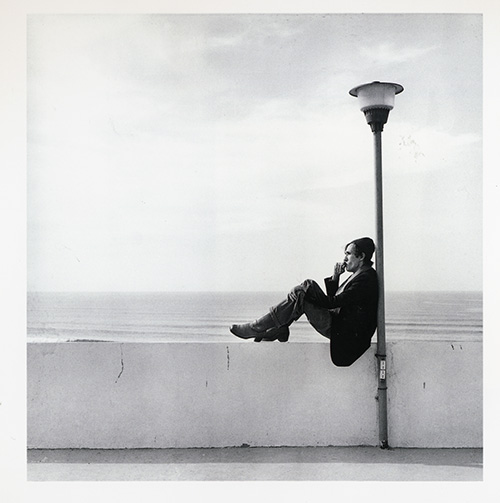
Travel to Morocco, 1982, photo by Isabella Gherardi
On 27 September, having recently left the clinic, he installed in the AAM/COOP studio in Rome, assisted by his friend the art dealer Francesco Moschini, the eleventh “Duetto,” one of a series of exhibitions which paired an artist and an architect. AB was paired with his friend Ettore Sottsass Jr., exhibiting for the second time the very private work in progress Il Muro and a large Clessidra.
“Entering the gallery, there is a bit of ‘wall’ on the right and a bit on the left, so the head looks at it like a ping pong match… Then there’s the repertory of Sotsass’s drawings and ideas set in horizontal cases and at the far end of the gallery there’s another white painting by Boetti with a hole in the middle.”
In October there was an important group exhibition in London at two venues, the Hayward Gallery and the ICA: “Arte italiana 1960-1982,” organized in partnership with the City of Milan. AB was represented by four early works: Colonna di carta dating from 1968, the offset poster Faccine del ’77, Io che prendo il sole a Torino il 19 gennaio 69, a Mappa and Aerei in blue ballpoint. On 30 November, in Milan, he had a solo exhibition at the Galleria Toselli. On display were a Clessidra cerniera viceversa and the embroidery Pack.
In the course of the year the Padiglione d’Arte Contemporanea in Milan welcomed the traveling exhibition (already presented at the Power Gallery in Sydney and at the University of Queensland) “Spelt from Sibyl’s Leaves, Explorations in Italian Art” curated by Luigi Ballerini. The exhibits included Gli anni della mia vita, 720 lettere dall’Afganistan presented with the related book by Dastaghir, a Mappa and two composi- tions of Natura una faccenda ottusa.
The year ended with a long interview with Bruno Corà, Un disegno del pensiero che va. The artist reflected on his past work, but also looked toward the future:
“The Chinese say that in a painting there has to be a visual element, calligraphy and poetry. In my work all three of these ingredients are present because a painter also has to be a good poet. I don’t know if I’m good or bad, but I want to be a poet, too, writing in my own way. By this means I present something written, as a writer. Mine is writing about thought, which goes where it will…”.
1983
After a lengthy convalescence, AB began his new life in his home in the Monteverde district on the Janiculum. He took on a third regular assistant, the young Florentine artist Andrea Marescalchi. An excellent designer, down to 1990 Marescalchi was kept busy copying magazine covers in pencil. That the genre increasingly fascinated AB, who saw it as representing all kinds of information as well as standing for the inexorable passing of time.
With the help of “Bobo” Marescalchi and his other assistants, AB began to turn out a considerable number of works in ballpoint (on paper) or in embroidery (on fabric). In the ballpoints, they consisted of sentences presented in the previous decade as embroidered squares, written in block letters or concealed in the interplay of commas and renewed in their color combinations. Examples were Amazzare il tempo, Sragionare/in lungo/e/in largo (blue/green/red/black) or the later Uno/nove/otto/quattro (blue/red/green/black) in 1984.
In the case of the embroideries, since he had never broken off his contacts with occupied Afghanistan, AB gradually received by mail those Mappe he had commissioned in ’79 without being able to take delivery of them personally. He now mailed out new Mappe to be embroidered.
These were sheets of linen which he fully prepared at his studio in Trastevere, indicating the geographic pattern and the colors of the flags and inscriptions to run along the borders, with texts that stand out forcefully as a challenge to the military occupation: “Alighiero and Boetti at Kabul Afghanistan in 1983 the progressive vanishing of habit,” or “Alighiero and Boetti at Kabul Afghanistan in 1983 leave the certain for the uncertain and vice versa.” The production of the Mappe continued in this way up until 1985. His intermediary was no longer Dastaghir, whom he lost touch with when he fled from occupied Kabul. It was now Salman Ali, his assistant in Rome, who was still in contact with his family. Some of whom were at Jagori in Afghanistan, while others had sought refuge on the borders of Pakistan.
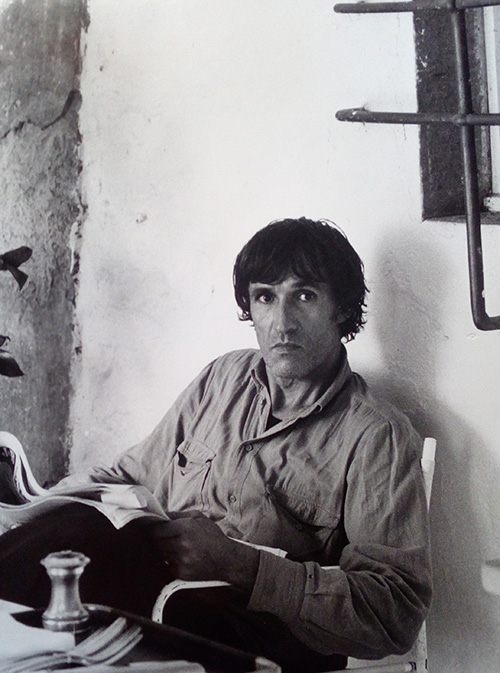
Alighiero Boetti, 1983, photo by Milton Gendel
Besides the Mappe, AB had a certain number of what he called “embroideries of letters” made in Afghanistan. These were large colorful compositions with phrases in block lettering. These tapestries “of a thousand colors,” as more than one embroidered text reads, are true stories to be read, vertically or horizontally, like Addizione and Sottrazione, which he dated ’83 and ’84.
AB was happy to return to work and was deeply aware of the thread uniting his now mature work: the centrality of time and the wisdom of letting it flow. This was embodied, as always, in works of different kinds: images from magazines, surfaces covered with hatching in ballpoint, embroideries and maps.
In a conversation with Bruno Corà, after the previous autumn’s convalescence, he said:
“…If you swim against the current in a river, after a while you’ll come to a tributary and have to face the dilemma whether to choose to go right or left. Instead, if you go downriver, following the current, you’ll never have to choose. I would like keep following the current and never choose… My works in ballpoint are concentrates of time, an enormous dilated time span. The embroideries, too. And I’m pleased that for certain embroideries I sometimes have to wait up to five years. Strangely I have the patience to wait for them, or rather I don’t wait for them, they arrive when they arrive.”
As he resumed work, the exhibitions multiplied, both in Italy and abroad. Among the most significant was a brilliant solo exhibition at the Galleria Pieroni in Rome in February, which exhibited four Pier Piets in different colors; I Mille Fiumi più lunghi del mondo, the large tapestry (version in black and white) with an embroidered transcription of the names and lengths of the thousand rivers contained in the book Classifying the thousand longest rivers in the world; and finally some variants (in ballpoints of different colors) of Clessidra Cerniera e vice versa.
Other solo exhibitions followed in northern Italy. AB enjoyed staying at his friend Lisa Ponti’s home on Via Randaccio in Milan.
In March, he had a solo exhibition at Franz Paludetto’s gallery in Turin, where he displayed a single work, the white and green version of I Mille Fiumi più lunghi del mondo, which had just arrived from Kabul.
In April, at the PAC in a two-man show with Carlo Accardi, he exhibited together for the first time the two versions (in black and white and white and green) of the tapestry I Mille Fiumi più lunghi del mondo. The other works presented were of historical importance: I sei sensi of 1973 in eleven panels and Aerei of 1977, a large triptych (175 × 300 cm) with hatching in blue ballpoint.
The group exhibitions included: “Trenta artisti italiani, 1950–1983” in the church of San Samuele in Venice; “Arte a Torino dal 65 all’83” at the Kölnischer Kunstverein in Cologne; an exhibition organized for the tenth anniversary of the Galleria di Massimo Minini in Brescia.
In November, a group exhibition at the Galleria Pieroni brought together the three old friends: AB, Sol LeWitt and Giulio Paolini. On display were Boetti’s early drawings of magazine covers under the title Novembre 83, a selection of eighteen images of magazines published that same month. The following year AB exhibited this panel together with Ottobre 83 and Dicembre 83, a quarterly collection that heralded the large sequences based on whole years (Anno 1984, Anno 1986, Anno 1988, Anno 1990). Of this work, AB commented in 1984:
“In that month, there were millions of images. Today, perhaps there are only a hundred. Then there will only remain this faded copy once colored.”
1984
Early in ’84 Boetti participated in a group exhibition, “Il Modo Italiano,” in Los Angeles, presented at the various campuses of the University of California. Besides displaying a group of earlier works, Boetti produced a permanent wall mosaic, here shown for the first time. Measuring 3 × 3 meters, it translated the mechanism of Alternando da uno a cento e viceversa into black and white ceramic. The preparatory drawings had been entrusted to the invention of the students.
The work was permanently embedded in the west wall of the Fine Arts Building of California State University at Northridge. Louise Lewis, director of the university gallery, wrote: “The finished mosaic is exquisite. It is also startling, enticing and challenging. It is both a visual feast and a cerebral code. The tile invites tactile exploration—one of the rare instances where touching the artwork is encouraged.”
On 12 June, he took part in “Coerenza in coerenza. Dall’Arte Povera al 1984,” curated by Germano Celant, at the Mole Antonelliana in Turin. His most recent works exhibited included: Ordine e Disordine of 1980, an installation of one hundred small embroideries, Quattro Moli of 1982 (i.e. four Pier Piets in ballpoint on paper) and Ottobre ’83, Novembre ’83 and Dicembre ’83, presented together for the first time.
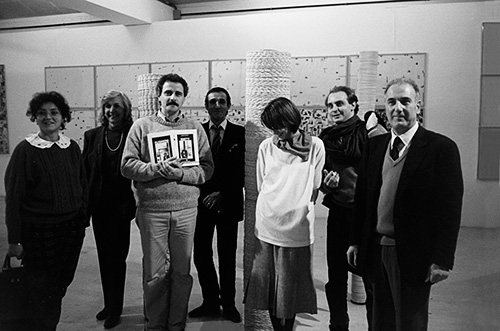
Inauguration of the retrospective at the Municipal Art Gallery of Ravenna with (from left) E. Gentile, M. Bonomo, G. Gentile, AB, A. Bonomo, F.Valentini, G. Nati, photo by Giorgio Colombo
He moved to a new studio on Via del Pantheon: the building’s magnificent architectural form now appears in numerous notes and drawings by the artist, often accompanying his signature: “all’amato Pantheon” or “Accanto al Pantheon.” The latter even became the title of a volume of photographs by Randi Malkin- Steinberger. Taken between March and June 1989 in AB’s studio, they were published in 1991 by Prearo, with texts by critics selected by the artist.
He produced new compositions in mixed media on paper, which were presented in September at the exhibition at the Petit Palais in Geneva, organized by the Erick Frank Gallery, and subsequently in October in the exhibition “Disegni 1984” at the Galleria Franz Paludetto in Turin. These new, highly colored collage-drawings (such as Nuotando al gerundio) always allow for the insertion of calligraphic elements, free reflections, private annotations added by AB with his left hand, as if to exemplify his declaration: “Writing with the left hand is drawing.”
“Why do we use the active verb ‘nuotare’ [swim] and the reflexive verb ‘tuffarsi’ [dive], instead of ‘nuotarsi’? The reflexive form should be used for both acts. They have in common the same liquid element, H2 O, in which the body is immersed and compressed in its every part. Like the air but with more ‘sense.’ So between swimming and diving my last evening of August 1984 comes to an end. In Rome fairly happy.”
In these drawings the dense “swarming of nature, a dull affair” evolves towards an ever lighter harmony, with “jungles” of tigers, panthers, monkeys, frogs, fish and “pools of divers” of Pompeiian memory. Performed in serene solitude, without the assistance of others, they grew out of a sort of natural urge to compensate for the practice of delegating his work, as in his ballpoints and tapestries.
“Concentrating on oneself or dispersing oneself outside oneself to shatter to be pulverized to become a thousand droplets that will fall that will fall on a thousand rivers of grass and every drop has its sound, its note, so that the rain will make music and be spread by the wind … rain and wind —sweet and violent energies but perhaps the best moment is the moment before rain or the clear calm before the wind rises.”
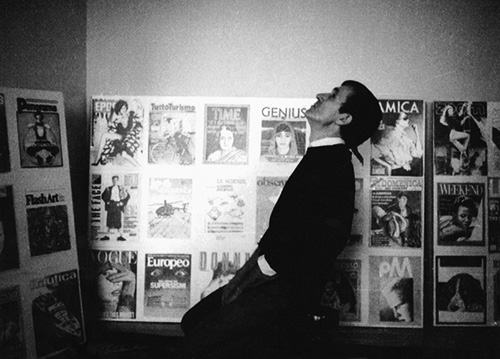
Alighiero Boetti in front of the Copertine (year 1984)
Among the small square embroideries still entrusted to the embroiderers in Afghanistan, new inscriptions developed, including Divine astrazioni, Verba volant scripta manent and I fregi e gli sfregi.
An important anthological exhibition titled “Alighiero Boetti” opened at the Pinacoteca Comunale in Ravenna on 15 December. It presented over fifty works from the sixties (like Lampada Annuale of ’66 or Colonne of ’68), from the Arte Povera period, down to the conceptual breakthrough of the sixties (Cimento dell’Armonia e dell’Invenzione of ’69), and his most recent output, with the magazine covers of October 83 and the drawing Articolazione of 1984 (the image used on the invitation).
For the occasion a book titled Alighiero & Boetti94 was published by Alberto Boatto. It not only documented the works exhibited but constituted a monograph with a full bibliography (by Guido Nati) which served as a general updating of the 1978 Basel catalog.
1985
The year was notable for numerous journeys and proved very productive. AB made an exploratory journey to Peshawar in Pakistan on the Afghan border, to check out the potential for resuming production of the embroideries there. The Afghan merchant Jalil, an acquaintance of his, helped find possible embroiderers among families that had fled from Afghanistan after the Soviet occupation. The first embroideries from Peshawar were only completed in 1988. Meanwhile the embroideries still being made in occupied Afghanistan were exhibited at various solo exhibitions in Italy. They included “Ammazzare il tempo” at the Galleria Chisel in Genoa and “Arazzi maggio uno nove otto cinque” at the Galleria Bonomo in Bari.
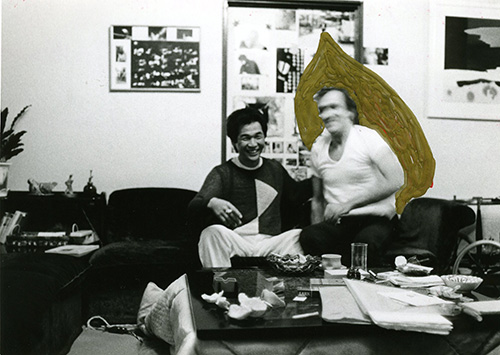
Boetti in Japan with the calligraphy Enomoto, 1985, photo by Alessandra Bonomo, «retouched» by Mario Schifano
In May, for the “Incontri internazionali d’arte” at the Palazzo Taverna in Rome, AB presented the sequence Anno 1984: 216 magazines covers (eighteen for each of the twelve months), arranged on twelve large panels, reduced to uniformity by the black and white of pencil drawing.
He made other journeys, for example to Tanzania, where he stayed on the island of Zanzibar. As always on journeys to distant places, he composed a number of postal works on the spot and mailed them.
He made his second visit to Japan, intended to coincide with an exhibition at the Watari Gallery in Tokyo. It was canceled at the last moment because of disagreement over the theme of the exhibition.
On this occasion he had the pleasure of again meeting up with the dealer Kazuo Akao, who had welcomed him to Tokyo five years before. Akao’s Art Agency no longer existed but the collector and dealer welcomed AB to his private museum in Osaka. (His collection consisted of ancient art with the exception of three contemporary artists: On Kawara, Beuys and Boetti.) There AB was able to work with a master calligrapher, Enamoto San.
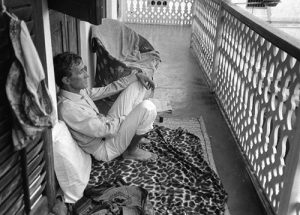
Alighiero Boetti in Zanzibar, 1985, photo Alessandra Bonomo
“I wished to work with the Japanese calligrapher on the concept and the word ‘wind.’ Together we did some pictures on it. There are scores of ways of writing “wind” in Japanese… We chose a couple and then prepared the paper on which they were to be traced. It consisted of a series of folds, regular, irregular, horizontal, vertical, fan-shaped, etc. After folding the paper, he would trace the chosen ideogram on it. When the ink dried, the paper was unfolded and then glued to a support. The result was the decomposition of the initial ideogram. It was only when the work was completed that I realized that strangely enough I had gone to do a work on folds in the country of the fan. To Enamoto it was like drawing on a closed fan, which on being opened decomposed the image, while in Japan normally the procedure is the opposite: they paint on an open fan and then close it to conceal the image, folding it on itself.”
As a result of this meeting AB, who already had a passion for Japanese culture and Zen in particular, learned specific new techniques of working with paper, such as folding, which became a new element of composition together with calligraphy, drawing in pencil and in colored inks, and the stamping of red seals. (He had a seal made with his name in Japanese characters.) The influence of master calligrapher Enamoto can be seen even in his penning of hand-written notes and the titles of works.
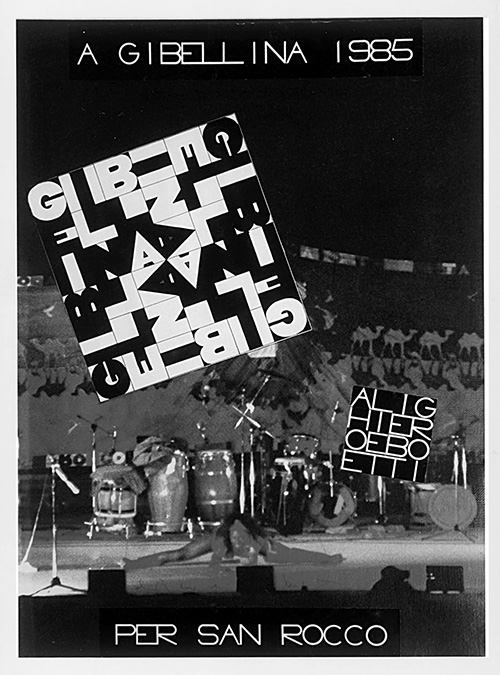
In the August holidays, AB had a processional banner sewn for “Lu presente,” the festival of Saint Roch in Gibellina (Sicily). It was over 2 meters high and 10 long, and was sewn by the women of the village. During the year AB also participated in important group exhibitions, mainly abroad. In Madrid (from January to April) and New York (at P.S.1, from October to December), his works were presented in two important exhibitions devoted to Arte Povera, both curated by Germano Celant: “Del Arte Povera a 1985” and “The Knot. Arte Povera at P.S.1.” Between September and October AB was also represented at Kassel (in a group show at the Kunstverein) and the Alvar Aalto Museum.
In December, at the Castello di Rivoli in Turin, AB took part in an exhibition commemorating the activities of Turin’s Museo Sperimentale in the sixties.
All these exhibitions confirmed the process, now widespread, of historicizing Arte Povera by displaying its subsequent and highly diverse development in the works of the founding group of artists.
1986
In February, the Nouveau Musée of Lyon-Villeurbanne mounted a major anthological exhibition of over fifty works, organized by AB in collaboration with Giovan Battista Salerno. The title, “Alighiero e Boetti. Insicuro noncurante,” came from the 1976 portfolio. It consisted of the same systematic documentation of techniques and reviewing of the essential stages of the work done to date.
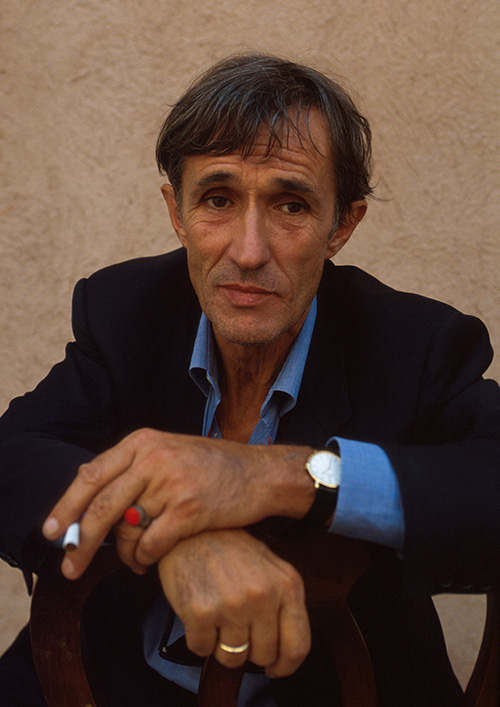
Alighiero Boetti at the Venice Biennale, 1986, photo by Graziano Arici
For the occasion Boetti produced and exhibited new versions of three works from the Arte Povera period: Pavimento, Rotolo and Niente da vedere niente da nascondere. On the cover of the exhibition catalog (a witty photo of AB concealed in the midst of a throng of Japanese students), Salerno published, next to images of individual works, the start of a glossary titled Manuale di conoscenza, intended to become a developing text on all AB’s work, but it remained unfinished.
The exhibition was reprised, with the same title in Italian but with some variants in the works exhibited, at Villa Arson in Nice and at the Stedelijk van Abbemuseum in Eindhoven.
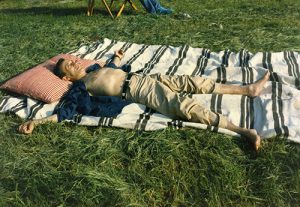
AB sunbathes in Todi, 1986, photo Alessandra Bonomo
In April and May Boetti had two solo exhibitions where he presented numerous works on paper that exemplify the “Japanese” spirit of this period, distinguished by rapid red or blue lines made in India ink. They were “ALIGHIERO E BOETTI” at the Galerie Pietro Sparta in Chagny and “Esercizi 1986” at the Galerie Susan Wyss in Zurich.
In the drawings, as always, words and lines are interlaced. Running through the works exhibited were texts like:
“Going against time and against wind and feeling the profile of the wind; going with time present without the poisons of the past, without the honey of the future.”
“Alighiero e Boetti in the limpid, clear bright and long-awaited spring of the year 1986 here in Rome thinking about the gardens of the Orient and time of the Orient.”
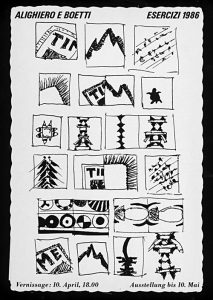
Invitation for the “Esercizi’86” exhibition, Zurich, courtesy Susan Wyss
Boetti took part for the third time in the Venice Biennale, now in its 42nd edition. He was represented in the exhibition “Arte e Scienza,” curated by Maurizio Calvesi, with a selection of works from the sixties and seventies, including Gemelli (1968), a ballpoint titled 1974 and a 1977 example of Orologio annuale.
In summer AB took on a highly qualified assistant, the young scholar Massimo Minninni, commissioned to supervise the organization of exhibitions and bring order into the documentation of the works. A difficult task…
At the end of the year AB exhibited Contatore (1966) in the group exhibition “Il Cangiante,” curated by Corrado Levi at the PAC in Milan.
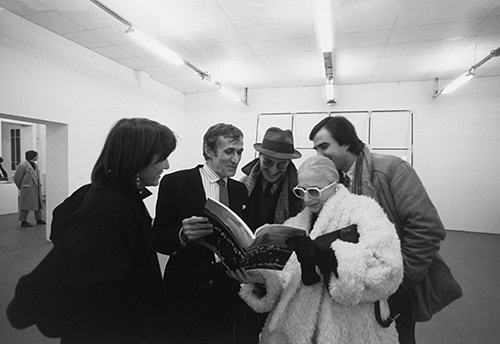
Inauguration of “Alighiero e Boetti, insecure noncurante”, Nouveau musée of Villeurbanne, France with (from left) A.Bonomo, Boetti, Giulio Paolini, C. Stein, G. Benedetti, photo by Giorgio Colombo
1987
The focus of AB’s interest continued to be on “private” works on paper, with the cheerful presence of a jungle of animals and the use of the technique of folded paper.
In February, the Galeries Liliane & Michel Durand-Dessert in Paris presented the group exhibition “Arte Povera 1965–1971”: AB was present together with all of the founding artists of the movement. On display were his Catasta of 1967 (made up of twelve elements), a large Mimetico of 1980, and the work titled Verso sud … dating from 1968, added on that occasion to the permanent collection of the Musée National d’Art Moderne, Centre Georges Pompidou.
If the emphasis of the group exhibition was on the sixties and seventies, the numerous solo exhibitions held the same year concentrated on his new works on paper, mostly stemming from his Japanese experience.
“And then there are the brushstrokes, laid on simply without any mastery, above all touches of red, it’s the first color… There is the Orient, but in this undifferentiated way of laying on all the colors together without ever mixing them, there is also the tradition, art and craftsmanship of Brazil, Guatemala, Peru, the Hopi, the Eskimos. It’s there that you find creativity is still common, not framed in roles and spaces the way it is among us.”
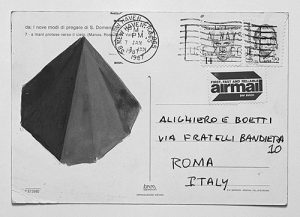
Postcard sent by Sol Lewitt to AB, courtesy Carol Lewitt
In February the Galleria Lucio Amelio in Naples pre- sented a memorable exhibition titled “Tra sé e sé,” referring to the mirror image of the artist’s head and hands, presented in black and white in the seventies and here reprised in colored India ink, abstract motifs and calligraphy. The gallery-owner was a friend of Boetti’s and for him he produced these eleven large drawings (150 × 100 cm), which were all reproduced as full-page plates in the splendid catalog in the gallery’s typical format.
In Milan, two important exhibitions opened on the same day (25 March). The exhibition at the Studio Casoli presented only works on paper, all done in Osaka on folded paper with Enamoto San. They included the works related to the different names of winds, Undici parole sparse nel vento and the large diptych Ordine e Disordine, executed in ideograms, the Oriental response to Boetti’s binomial square Ordine e disordine. Speaking of the calligrapher’s gesture on the still fold- ed paper, AB told Sandro Lombardi in the conversation cited above:
“The culminating moment of the whole operation remains the execution of the ideogram, which is always traced in a single movement, and the brush, which at the beginning is laden with ink, is almost dry by the end.”
The second exhibition at the Galleria Christian Stein was notable above all for two impressive friezes (150 × 700 cm), each made up seven elements. In the lower part, rows of monkeys chasing each other are drawn in different colors, while in the upper part, almost monochromatic, run drawings and collages made up of postcards, newspaper clippings, and calligraphy.
“These small forms that I make out of paper clippings are modules to be used rapidly, lightly, as I believe painters did under the Roman empire, when they probably used templates. The important thing, which also becomes happiness, is to define a form. You choose a monkey dancing or a panther and invent the image using quite simple manual means. You can reproduce it. This and the alchemy that makes happiness visible.”
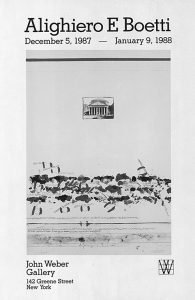
Personal invitation from John Weber, December 1987
In May he had an exhibition at the Galleria Alessandra Bonomo in Rome. For the occasion AB prepared a pasteboard invitation bearing Alessandra’s name split up as if by a reopened fold, on the model of the ideograms he had done with Enamoto.
In the middle of August the Städtische Kunsthalle in Düsseldorf presented the group exhibition “Similia Dissimilia, Modes of Abstraction,” curated by Rainer Crone. In fall the exhibition was then presented at three venues in New York: the Wallach Fine Arts Center of Columbia University, the Leo Castelli Gallery and the Sonnabend Gallery. Boetti exhibited works from the Arte Povera period (Sedia, Colonne e Colori) together with a work on paper from ’87 (Tra sé e sé). In the catalog the curator John B. Ravenal concluded his critique of the artist by observing, “Boetti undermines the tyranny of coherence by inserting fissures and paradoxes in our perceptual habits…”.
On 5 December, in New York, the John Weber Gallery presented a solo exhibition with eleven versions of Tra sé e sé, all from 1987, a drawing in mixed media titled Via del Pantheon 57, the image used on the invitation, and two long friezes based on a collage of Cartoline astratte and Cartoline etrusche e altre.
At the year’s end a small but valuable exhibition opened at the Galleria In Arco in Turin. Titled “Giacomo Balla Alighiero e Boetti,” it presented works on paper. The invitation bore a haiku by Boetti:
“Opposites annul, intermediates soothe and neighbors repel each other: but what does a leaf do on the ground?”
One of the collages on display had the following:
“The natural parity of comparison.”
1988
In 1988 Boetti began to have the embroideries sewn in Peshawar (Pakistan) by immigrant Afghan families: not only small embroideries, but mainly large tapestries with lettering. (Boetti invented some new phrases, like Talvolta luna talvolta sole). Many of these new embroideries, all designed in his studio near the Pantheon with his assistants, were produced in the following two years. In assembling his word squares in checkerboard or other patterns, AB almost always included texts in Farsi, written in Pakistan by the heads of the families or regular calligraphers (never by the women, for various local social reasons).
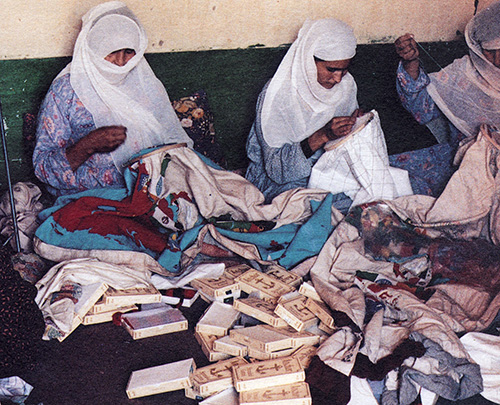
Embroiderers in Peshawar, Pakistan 1990, photo by Randi Malkin Steinberger
The inscriptions sometimes express a spontaneous lyricism, at times heartfelt militant appeals: “White doves weep for Mahdi Ali and take flight, men pray for him. And look at the garden covered in red roses – Written by Sober”; or again: “Embroidered by Ali Ghiero Boetti assisted by Abdul Afghan Jalil, Peshawar, calligraphy by Mohammed Yasin. I will not stop fighting until I reach the goal. Many Muslim mujahidin have lost their lives like so many butterflies on the front, they have resisted the brutality of the cruel Russians.”
It should be observed that even when new embroideries were made in Peshawar, in particular of Mappe with a new cartographic projection and flags updated following the political conflicts of the eighties, AB continued across the uncertain boundaries between Pakistan and Afghanistan to commission work from families still in the country. This is shown by other embroidered inscriptions, such as “Jagori Afghanistan 1989.” On almost all the embroideries made in Pakistan, AB would write next to his signature “a [i.e. in] Peshawar by Afghan People” or, in the inscription embroidered along the edges, statements like, “In Peshawar in Pakistan AEB had this embroidered by unknown Afghan women in the spring of 1989,” or variants.
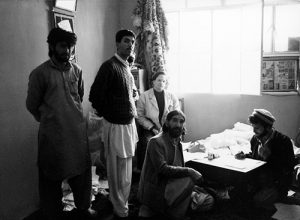
The collaborator Massimo Mininni with the Sufi master Barang and his assistants, Peshawar Pakistan, courtesy of Alighiero Boetti Archive
The series of works titled 50+1 have a different structure and are of special importance. They are a sequence of tapestry squares in which AB’s text is interwoven with poems by Sufi Barang, works exhibited in Paris the following year at “Les magiciens de la terre.” All Boetti’s solo exhibitions this year underscored the continuity between his art in the seventies and his recent works (ballpoints, embroideries and drawings on paper). Of particular interest were two exhibitions held in Milan: “Alighiero Boetti – opere 1968–1981” at the Galleria Massimo de Carlo and “Alighiero e Boetti. ‘ALTERNANDO…’ tra tecniche diverse 1970–1986” at the Galleria di Porta Ticinese.
It presented the conceptual mechanism behind Alternando da uno a cento e viceversa from the first experiment embroidered in black/ white on squared paper down to the works on paper.
The group exhibitions were historical in character and placed AB’s work beside that of the great masters of the twentieth century. In April Luigi Meneghelli curated “20 anni fa” for the Galleria Studio la Città di Verona. It was repeated in Rome at Giuliana de Crescenzo’s Studio d’Arte Contemporanea. The group exhibition presented works by Colla, Fontana, Leoncillo, Novelli, Pascali, Arico, AB, Gilardi, Paolini and Pistoletto. Boetti was represented by the five Colonne of paper and a stucco on wood.
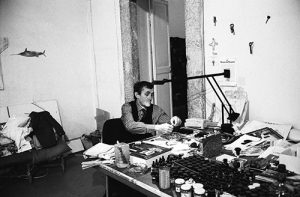
AB in his studio at the Pantheon, photo by Giorgio Colombo
In June, the Castello Estense di Mesola presented “Mosaico e mosaicisti,” curated by Laura Gavioli. The group exhibition presented works from across the whole twentieth century, ranging from Severini to Afro and Sironi to Schifano. Boetti exhibited a large mosaic iconographically related to the friezes of animals and stylistically to the classical mosaic tradition.
As for group exhibitions abroad, in addition to those in Cambridge, Athens and Nantes, “Chamber Sculptures,” organized by the United Nations, was of particular significance. It was subsequently presented at the Museum van Hedendaagse Kunst in Utrecht, then at the Palais des Nations Unies in Geneva and the Fisher Gallery at the University of Southern California. Towards the year’s end, in Rome a notable solo exhibition titled “Piopermariemonti” opened on 20 December at the Galleria Pio Monti. It presented a series of embroidered squares specially worked with the sixteen letters in “Pio per mari e monti.”
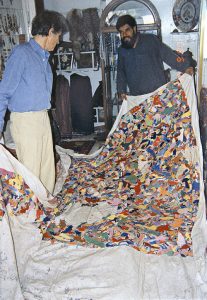
AB in Peshawar controlling an Tutto, photo by Randi Malkin Steinberger
The catalog, edited by Achille Bonito Oliva, took the form of an ironic “collective work”: it matched the “portrait” of each embroidery, differing from the others in the pattern of its colors and execution, with the photographic portrait of its buyer.
“I designed some 150 words that could be arranged in a square. Today when I come across expressions like ‘la forza del centro’ (‘the force of the center’), a yoga precept, I know intuitively that the number of its letters allows it to form a square. I produced up to a hundred examples of each of these pieces. Each one is different in coloring and the special style of the woman who made it. So it is neither an original work nor a multiple.”
AB purchased a new home in Rome on Via di Teatro Pace. He moved in after restoring it in 1989, while keeping his studio at the Pantheon.
1989
The busy rhythms of work in the previous years, when AB produced drawings on paper while delegating embroideries and ballpoints to others, gave way to a period mainly of promotion and exhibitions. He was represented at various important solo and group shows, above all in Europe.
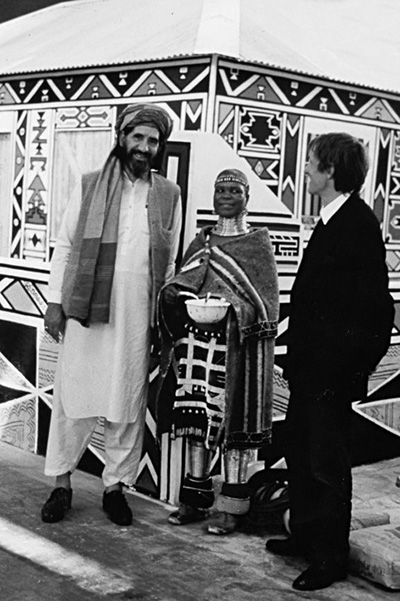
Inauguration of “I magiciens de la terre” at the Center Georges Pompidou in Paris. AB with Sufi Barang and Esther Mahlangu, courtesy André Magnin
On 12 January, in Brussels, at the Galerie Lucien Bilinelli: opening of the solo exhibition “Alighiero e Boetti” with a number of embroideries of large dimensions (principally those with structured cruciform inscriptions in black and white) and Tutto, a series also now made in Peshawar.
For the occasion, the artist wrote the gallery owner:
“Dear Lucien, to avoid dispelling my efforts and diluting myself I need to keep still and then set off again to new places and feel the wind separated by the tip of my nose and then my cheekbones and ears and the hiss growing stronger and then fading in the distance and being dispelled and diluted.”
On 21 March, the Edward Totah Gallery in London presented a solo exhibition titled “Alighiero e Boetti,” with particular prominence being given to the polyptych Cartoline astratte, made up of nine colorful sheets.
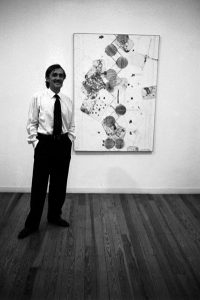
AB at the opening of the staff at the Toselli Gallery in Milan, courtesy of Archivio Alighiero Boetti
On 8 June, the Galleria Toselli in Milan opened “Cieli ad Alta Quota,” a wide-ranging survey presenting works going back to the seventies. It included the new cycle of works that gave the exhibition its title: Aerei on drawing paper, executed in pencil and watercolor by Guido Fuga, who had partnered Boetti in the conception of the first triptych in ’77. These Cieli ad alta quota were extremely refined compositions, each quite different from the others.
“Cieli ad Alta Quota [High Skies], a space where the void begins, where parallels meet and get to know each other for the first time, where colors are pulverized and the lack of oxygen favors extraordinary encounters and celestial visions.”
Among this year’s group exhibitions, on 20 January the PAC in Milan mounted “Verso l’Arte Povera. Momenti e aspetti degli anni ’60 in Italia.” It included three early pieces by Botetti (Zig Zag , Ping Pong and Io che prendo il sole a Torino il 19 gennaio 1969). The traveling exhibition continued to Lyon, where it was presented in the Espace Lyonnais d’Art Contemporain. Paris in May saw the opening of the historic exhibition “Les Magiciens de la terre,” conceived and curated by Jean-Hubert Martin, at the Centre Georges Pompidou and the Grande Halle della Villette.
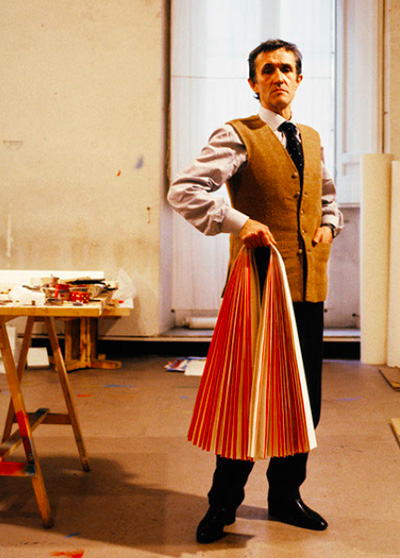
AB with his pleated paper in the Pantheon studio, photo by Randi Malkin Steinberger
It was the first exhibition of contemporary art that sought to be global in scope. A hundred artists were chosen, from very different cultures, so that AB was brought into direct contact with artists representing traditions outside Western culture and with types of works ranging from craftsmanship to sacred ritual. He exhibited 51+1, fifty-one large square embroideries— a roomful—in which his Italian texts were combined with texts in Persian by Sufi Barang, who came from Pakistan specially for the opening. It was on this occasion that André Magnin, Jean-Hubert Martin’s assistant, noting the subtle affinity between AB’s poetic and that of the African Bruly-Bouabré, initiated a project involving them both at the Dia Center for the Arts, New York in 1994.
“Would art be as arbitrary and reductive as any other kind of grid imposed on reality? Boetti answers by relating nomadism to the modes of representation and existence. Anticipating the theories of the Transavanguardia, he develops a true ‘eulogy of flight’ and geographical movement, continually regenerating his inspiration by contact with other cultures. Boetti remains elusive: when he took part in the exhibition ‘Les Magiciens de la Terre’ he arrived at the opening with one of his friends, a Sufi poet, silent, at his side… And by the way, where is Boetti at this moment?”
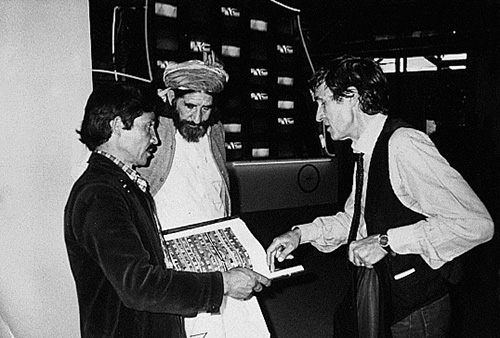
AB with Salman Ali and Sufi Barang at the inauguration of “The Magics of the Lands” in Paris, photo by Agata Boetti
In November the group exhibition “Art conceptuel, une perspective,” curated by Benjamin Buchloh and Seth Sigelaub, was held at the Musée de la Ville de Paris. The exhibition included conceptual works, and the critics chose thirty-eight artists, among them Anselmo, Boetti, Manzoni and Prini from Italy. AB exhibited two works: a 1984 reprise of the diptych Rosso Gilera Rosso Guzzi (conceived in ’67) and the immense black/white embroidery of I Mille Fiumi più lunghi del mondo (280 × 420 cm) presented in Ravenna in ’84.
1990
On 16 February, his second solo exhibition “Alighiero e Boetti,” opened at the Galleria Lucio Amelio in Naples, with a long frieze “populated by a colorful fauna of rhinoceroses, panthers, his beloved dolphins, swordfish and monkeys. The greatest pleasure in the world is to invent the world as it is without inventing anything.”
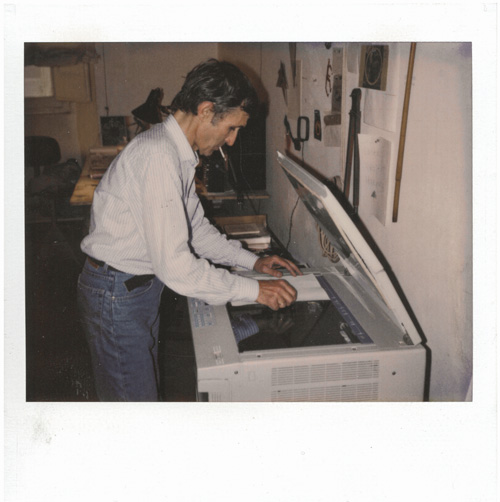
Alighiero Boetti in his studio, 1990, courtesy of Archivio Alighiero Boetti
The catalog had the same large format with colored plates as the one published in 1987. After the recent important exhibitions at the Centre Georges Pompidou and the Musée de la Ville de Paris, there followed a busy period with exhibitions in Parisian galleries.
On 6 March, the solo exhibition “Alighiero e Boetti” at the Galerie Adrien Thomas presented two large compositions in ballpoint pen: Uno Nove Otto Otto made up of four elements (1988) and Mettere al mondo il mondo of twelve elements (1978), a Mappa from 1983, a Tutto and a number of large Ricami di lettere, in which the Persian alphabet was interwoven with the Italian.
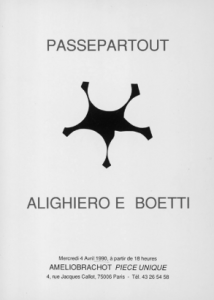
1990 Passepartout. Alighiero and Boetti, Galerie Amelio Brancho, piece unique, Paris
On 24 March, the Galerie Charles Cartwright mounted another solo exhibition. It exhibited Anno 1988, a work consisting of 144 magazine covers redrawn in pencil in black and white (twelve for each month of the year). The young gallery owner had a fine catalog printed with the 144 images, but AB banned publication because of a serious error: the reproductions were not ordered chronologically.
On 4 April, in Lucio Amelio’s new Parisian gallery (Pièce Unique, Galerie Amelio-Brachot), AB covered the whole available floor with a mosaic (380 × 415 cm), which reprised a drawing from ’72 titled Passepartout. The mosaic was laid by the cooperative of mosaicists based in Ravenna who had produced works in 1988 exhibited at the Castello Estense of Mesola in “Mosaico e mosaicisti.”
AB intended to produce at least two more mosaics: Direzioni Suggerite (a re-elaboration of Regno animale), for which the preliminary cartoon exists, and Tutto, for which only a small model survives. They were never made.
In the case of Direzione Suggerite, AB showed Mariuccia Casadio the plan for a large cultural center in Ravenna and explained:
“The mosaic will measure 10 m × 10 and is titled Direzioni Suggerite. Seventeen lines will indicate seventeen different directions… Each line has three characteristics that make it possible to follow it: writing…, the lines of animals (there is the line of the slug and the line of the horse…), and then colors corresponding to each animal.”
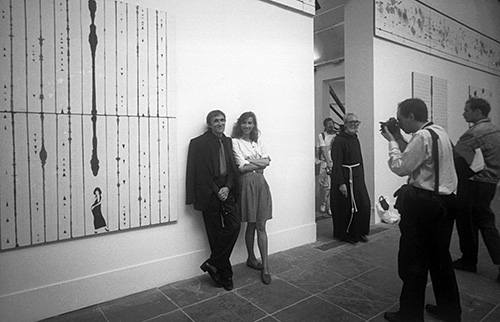
Ab with Caterina Raganelli at the Venice Biennale in the Personal Room, photo by Giorgio Colombo
AB also revealed he was deeply interested in artistic projects of this kind, as well as educational projects:
“I feel that in this period things are becoming feasible that I theorized twenty years ago and seemed impossible at the time… Environmental things, educational things, for outdoor spaces or other projects of the type have always attracted me. I had planned a playground, children’s books, objects, a thousand other things.”
Now prominent on the Parisian scene and again enchanted by the city where he had enjoyed living almost thirty years before, he made his home in Saint-Germain-des-Près.
At the same time, in Rome (on 8 March) the Galleria Pio Monti presented a long animal frieze, installed on the upper part of its walls, forming a decorative festoon.
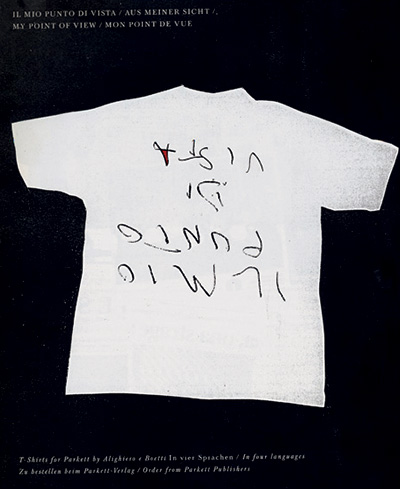
From Parkett, “My point of view” T-Shirt, 1990
AB also participated in the 44th edition of the Venice Biennale, with a personal room in the Italian pavilion curated by L. Cherubini, F. Baldoni and L. Vergine. He exhibited a continuous frieze that ran along the walls for 54 meters. In the lower part of the wall he presented ten other large works on paper. On this occasion he was awarded the Jury’s special Prize. In September he married Caterina Raganelli.
On 21 September, AB included his work in the traveling group exhibition “Le porte dell’oriente.” It traveled from Istanbul to Ankara and Athens, with its last venue in Ravenna a year later. Again on the theme of the East, he took part in another group exhibition held at Palazzo Reale in Milan titled “Il mondo delle torri di Babilonia.”
On 8 October, the Galerie 1900-2000 in Paris presented his work in “Art Conceptuel, Formes Conceptuelles,” a group exhibition of forty progenitors of the conceptual movement, from Vito Acconci to Lawrence Weiner. An impressive catalog documented the exhibition.
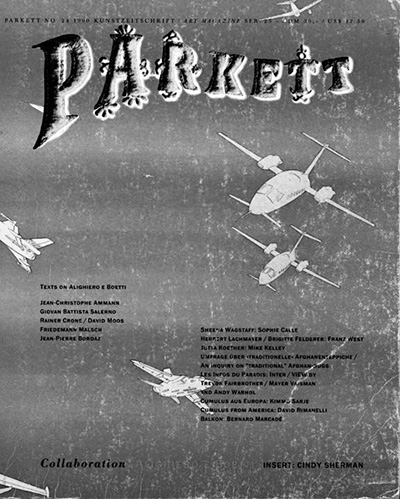
Cover Parkett, No. 24, June, 1990
Again in October, AB was among the artists represented at the Musée Contini in Marseille. The exhibition, curated by Bernard Blistène, turned on the Arte Povera section of the permanent collection of the Centre Georges Pompidou, Musée National d’Art Moderne. It presented the works already exhibited in Paris in April: a calligraphy in fast-setting cement dating from ’68 titled Verso Sud, a Mappa from ’73 and a work in ballpoint.
On 17 November, Salvatore Ala in New York presented “Alighiero e Boetti,” a true anthological exhibition starting from the Arte Povera period, passing through the archetypes of the conceptual period (a vast postal work, the ballpoint Mettere al mondo il mondo and the large triptych of Aerei in watercolor) and some especially significant embroideries such as Ordine e Disordine, a Mappa of ’74 in a hundred embroideries and a monochrome embroidery from ’89.
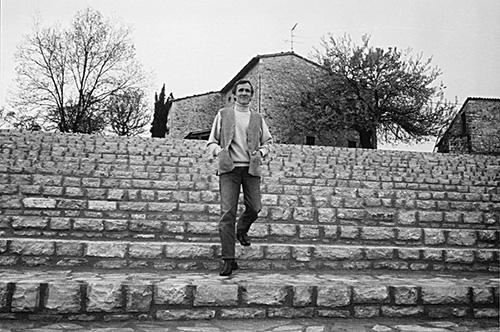
AB on the Todi’s stairs, 1990
In spring AB collaborated with the Zurich-based magazine Parkett, or rather with its editors Jacqueline Burckhardt and Bice Curiger on the layout of eighty- eight pages (plus the cover) devoted to his work in number 24 for June. The issue was made up of previously unpublished texts—by J.-C. Ammann, G.B. Salerno, R. Crone/D. Moos, F. Malsch, J.-P. Bordaz— and over thirty reproductions of works, constituting almost a personal exhibition catalog. Parkett was also the publisher of a silkscreen print, All about twins (a cover of Newsweek redesigned) and a T-shirt Il mio punto di vista (in various languages).
1991
AB increasingly used new technical instruments, light and rapid, related to innovations in communication: photocopies, faxes, in any case sheets of paper in commercial format. This gave rise to the series in A4 format he called Extra-strong. Each sheet, worked in pencil, colored inks, collages and various postmarks, became an illuminated microcosm, the page of a codex or diary.
His other passion for the media (newspapers, journals and magazines) found a new mode of expression: instead of getting Bobo Marescalchi to redraw images from magazine covers in pencil (after the 1984, 1986 and 1988 annual series, 1990 was the last), AB began to work on his own, photocopying in black and white. Talking about his experiments with the “Rank Zerox 3600,” begun in 1969, he complained of the reluctance of businesses to collaborate in artistic research:
“…There were a lot of ideas. I said a photocopier wasn’t just office equipment. In the year 2000 everyone will have one in their living room. Give me one to take home and I’ll document some of its possible creative applications. What other artists did, from Munari on, was to manipulate their mechanisms, alter the timing, change the quantity of toner, etc. But I was interested in the standard application of the photocopier. But they didn’t do anything.”
With the coming of the photocopier, AB finally had found “his living room photocopier” and operated it in his studio. Already in the eighties he had begun to produce books photocopied in limited editions (1984, 1986, 1988), parallel with the annate redrawn in pencil. In ’92 111 came out, a diary of 111 pages consisting of notes, private drawings and illustrations from magazines, all photocopied and so standardized in black and white.
All these “books,” in keeping with AB’s instructions, were bound in red cloth (of Afghan memory) with the title written in golden characters.
Parallel with the works in small format which he did himself, AB stepped up the output of large works which required lengthy production times and an almost managerial organization, by this time involving the work of many people.
He traveled less, preferring to send his collaborators, his children Matteo and Agata or his wife Caterina, to Peshawar.
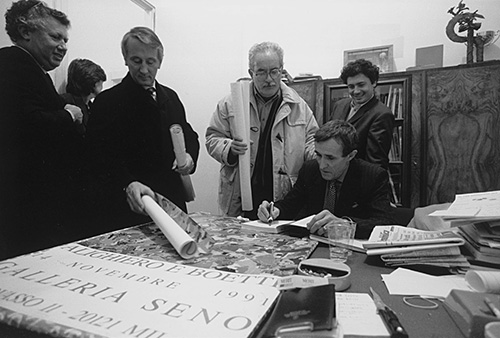
Inauguration at the Galleria Seno, Milan 1991, photo by Giorgio Colombo
This year there were numerous group exhibitions. Among solo exhibitions in Italy, those at the Galleria Bonomo in Bari and the Galleria Seno in Milan were particularly significant. At the first one of these, opening on 22 March, AB exhibited a continuous frieze that ran around the perimeter of the gallery, two postal works from ’89 (one done in Tanzania) and numerous works on paper with political themes related to current events, such as the Gulf War. The second, opening on 8 October, presented among other works an outsize Tutto and a series of drawings on paper on the theme of Bugs Bunny, which were shown for the first time. The group exhibitions were mainly historical in character, covering the period from Arte Povera to the eighties.
In March, the group exhibition “60–90 Trenta anni di avanguardie romane,” curated by Laura Cherubini and Arnaldo Romani Brizzi, was held at the Palazzo dei Congressi in Rome. AB was present with two works: Zig Zag from ’67 and Sale e Zucchero of ’73. On 26 April, the Munich Kunsteverein, presented “Arte Povera 1971 und 20. Jahre Danach.” The exhibition displayed historical works, including Io che prendo il sole a Torino il 19 gennaio 1969, 1970 in cast iron and some panels of the series Colori (Bianco Saratoga e Giallo Positano) linked to recent works, among which was a Mappa from ’83 and a Tutto of ’89. The catalog cover reproduced a Mimetico of 1981, which was not present in the exhibition.
On 20 September, at the Benedictine Monastery in Monreale, the exhibition “Ottanta Novanta,” curated by Francesco Gallo, exhibited Quindici, fifteen small embroideries from Kabul, a postal work of ’72 and the work on paper in two sheets, Collo Rotto braccia lunghe of ’76.
In November, the Palazzo della Permanente in Milan presented a highly original exhibition titled “Ricamata Pittura. Quadri ad ago dal XVII al XX secolo.” Only three twentieth-century artists were chosen: AB found himself in the company of Marcello Nizzoli and the greatly admired Alberto Savinio, with the embroidery Sandro Penna: Io vivere vorrei…
If in the catalog of “Magiciens de la terre,” in reply to the question, “What is beauty?” AB had answered “It’s what reminds us we are close to the gods,”116 on 16 May, in a conversation with Sergio Givone he declared:
“Beauty is a question of thought and the urge to create it. … What does futile mean? So is a poem futile, is putting four words in a line futile? I don’t think so. I think, as I said before, that the deep emotions in my life have come from artists, certainly not nature. Or nature as well, but elaborated mentally, intellectually. In fact I think art is the least futile thing there is…”.
Throughout the year AB devoted himself with great passion and energy to two ambitious projects: the traveling exhibition to be held in Germany from ’92 on and the immense project planned for late ’93 at Le Centre d’Art Le Magasin in Grenoble, whose preparation would take two years’ work in France and Peshawar, with a collective commitment to the study of the Pantheon as if it were one of Warhol’s factories. At the same time the large maps that were to be the last were in the hands of the embroiderers.
Alighiero seems to have worn himself out organizing his individual and collective works. He lived in greater isolation. He was concerned at the effects of the financial crisis (due to the First Gulf War) and sought refuge in the “artificial paradises” which he had never wholly abandoned.
1992
In February 1992 Boetti’s third child, Giordano, was born.
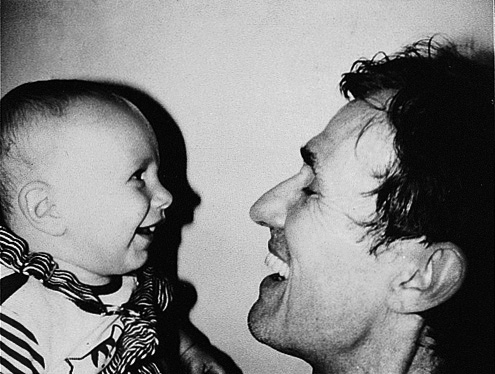
AB with Giordano, 1992, courtesy Caterina Raganelli Boetti
On 11 February, a solo exhibition opened at the Galerie Franck + Schulte in Berlin. It presented sixteen items divided between works on paper, in ballpoint and embroideries. The Mappe exhibited, dating from ’78, bore the words “in Kabul chaos reigns” running around the border.
In speaking of that distant “chaos” whether preceding the Soviet invasion (’79) or the civil war in post-Soviet Afghanistan, AB expressed his disenchantment and his extraordinary farsightedness about Taliban fundamentalism in conversation with Nicolas Bourriad in Paris:
“The Afghans’ strength of resistance to our civilization has always amazed me. Nothing ever changes. All the same, I hope Massoud returns to power. His opponent Makhtiar wears a black turban, the turban of Khomeini… And we know far too well what he gradually built his power on, starting from ’72/73. The Shah imposed on the Iranians Westernization to the bitter end, to a ridiculous degree. I remember the whores in miniskirts in Tehran. Warhol did a portrait of Farah Diba… In Afghanistan something similar happened, but it didn’t last long. One of the king’s sons even opened a nightclub in the embassy district of Kabul, it was called ‘24 Hours.’ But it closed after four months. The problem is no one was capable of emerging as a moderate on either side.”
The ten large tapestries embroidered to designs by Boetti and Paladino returned from Peshawar. They were exhibited at various venues: Emilio Mazzoli’s gallery in Modena, the Italian Institute of Culture in Toronto, the International Center of Contemporary Art in Montreal and finally, between December and January ’95, at the FRAC in Lille. In the meantime, on 25 September, the Galerie Leccese-Spruth in Cologne presented the group of fifty-one tapestries with poems by Sufi Barang which had been exhibited at “Les Magiciens de la Terre” the previous year.
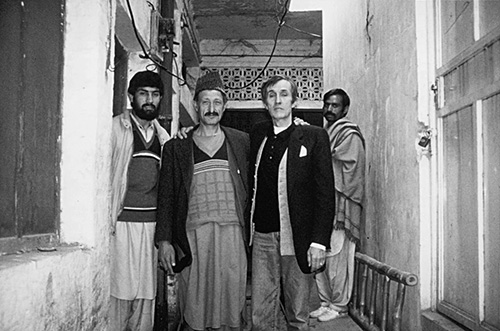
Boetti with Maestro Azam, 1992, courtesy Caterina Raganelli Boetti
On 28 September, the Kunstverein in Bonn inaugurated the important solo exhibition curated by Annelie Pohlen, which then moved to Münster and Lucerne. The title was taken from a text by Gustav Jung, Synchronicity as a Non-Causal Principle of Events.
It was chosen by AB both for its content, close to his favorite subject of “happy coincidences,” and because it lent itself to being inscribed (in German, consisting of forty-nine letters) in a magic square of 7 × 7. The subtitle was “Alighiero e Boetti 1965–1991.” The invitation to the exhibition also presented the quotation in German in gold on a red ground arranged in a square.
For the occasion, AB recreated Panettone (the original had been destroyed) and a second version of Io che prendo il sole a Torino il 19 gennaio 1969.
The catalog was a very lively experiment: AB himself asked a group of critics to each write on one work. In addition to the curator‘s introductory text, there were therefore thirty-five essays specially written for the exhibition.
Among the innumerable group exhibitions, three held abroad were notable. Two were in France in June: “A visage ouvert” at the Fondation Cartier at Jouy en Josas and “La Collection Christian Stein, un regard sur l’art italien” at the Nouveau Musée of Villeurbanne. One was held in Osaka in October: “Arte Povera” at the Kodama Gallery.
For the exhibition at the Magasin in Grenoble, scheduled for late ’93, AB began work on fifty khilim rugs in collaboration with Adelina von Furstenberg, director of the art center. He designed them to the same rule as Alternando da 1 a 100 e viceversa. In September ’92, on the basis of grids supplied by the Studio Boetti, fifty cartoons were drawn by students at thirty art schools in France and some twenty friends or relations. Subsequently his assistants in Rome transferred these drawings to the definitive scale (200 × 200 cm) for twenty weavers in Pakistan, who began work on them in early ’93.
Of the fifty khilim, Salerno wrote: “A design that starts from Rome, goes to France and circulates in some thirty towns, returns to Rome, leaves for Peshawar in Pakistan and is finally concentrated in Grenoble, travels the same distance that divides Oslo from the Bering Strait in a straight line along the sixtieth parallel, meaning the whole of Asia.”
AB went to Peshawar to meet the master carpet weaver Azam. He also made a journey to that “region of the soul,” as Caterina, who accompanied him, recalls, amid the mountains whose Pakistani side he had never seen before. It was “the last destination visited, the region of Rakaposhi (7,788 meters) in the mountain system of Korakorum which, continuing the Himalayas westward, joins up with the chain of the Hindu Kush in Afghanistan.”
AB had himself photographed by Caterina in a pantheistic gesture, in which the opening of his arms accompanied the mountain slopes, while his head, in the middle of the picture, was aligned with a snowy peak.
In preparation for the exhibition, the Afghan embroiderers of Peshawar were entrusted with a hundred small multicolored squares titled De bouche à oreille, which became the title of the exhibition as a whole. In the third phase of the project, AB planned an immense Lavoro postale based on a numerical progression going from one envelope with a stamp up to 121 envelopes (11 × 11): in all 39,976 stamps. The envelopes contained drawings and all of the drawings were exhibited beside the envelopes. The whole constituted an immense “carnet de voyage,” made up of parcels that really had traveled across France for weeks, with the collaboration of the Ministère des Postes, and like the preparatory drawings for the khilim, had made more than one journey between France and Italy to converge in the end on Grenoble.
1993
AB planned to make seven bronze copies of the Self-portrait, a complex sculpture conceived twenty years before. Three were made in ’94, the others only later. In June, the first example was presented at the exhibition “Sonsbeek 93” and permanently installed in the park of the Dutch museum in Arnhem.
In the studio AB designed a “classical” carpet of the Persian type that was to become the summa of all his iconography. He delegated the production of samples and the final cartoon to his new assistant, Simone Racheli. The work was entrusted to his usual weavers in Peshawar, who were still busy with the khilim. This large carpet (350 × 240 cm) was to be the last work that returned from Pakistan after the artist’s death.
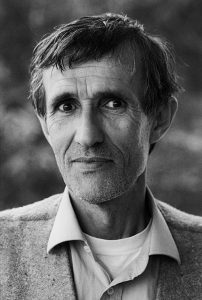
Alighiero Boetti, 1993
In March, a solo exhibition was held at the Galleria Christian Stein in Turin. The exhibits ranged from his very earliest works in 1966, never exhibited before, to some that were present in his first solo exhibition in ’67. This was to be AB’s last solo exhibition in Italy. Christian Stein had also presented his first.
He was busy with numerous other exhibitions, especially in France. For example “De la main à la tête, l’objet théorique” at the Domaine de Kerguehennec in Brittany and the Lyon Biennial titled “Et tous ils changent le monde.” Besides the preparatory work for Grenoble, AB was busy giving concrete form to his dialog with the artist Frédéric Bruly-Bouabré with a view to organizing a joint exhibition, scheduled for 1994 in New York.
“We brought the two artists together for the first time in Paris in March ’93. We were struck by the way they clicked and the warmth between them. While the project was being worked out with a view to an exhibition it was decided that each would call on the other ‘at home.’ It could have led to a true collaboration to extend the dialog envisioned between specific works. With his family Alighiero went to Abidjan, where Bruly lives today, and then the village of Zepreguhe where he was born.”
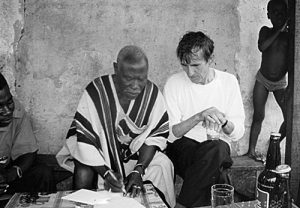
Alighiero Boetti and Frédéric Brouly Bouabré, Abidjan Ivory Coast, photo by Caterina Raganelli Boetti
AB’s stay in Ivory Coast, with Caterina and little Giordano, proved highly problematic for various contingent reasons. AB had difficulty relating to African culture, but with great intellectual honesty he was able to recognize the distinctive qualities of his friend’s work:
“There is a time for the great attractions… My attention was wholly turned to the East, the mountains of Tibet, tea, the Zen monks and their gardens… In Paris I happened to encounter African art, but I do not feel a particular interest in it. It’s extraneous to me on the emotional level, I’d say.
I can admire certain qualities, like its intensity, but it’s at a kind of distance from me… In the case of FBB it was the opposite. With his postcard format and the temporal continuity in his work, he can focus his attention anywhere, he can do anything. He speaks an essential language and deals with everything… But the basic idea is the same: to create a system, a world in which his discoveries about life, his marvels, can be reproduced, bringing out the phenomenal potential of our brain, our imagination.”
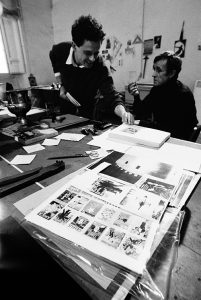
AB in the Pantheon studio with Andrea Marescalchi, known as Bobo
In June, at the 45th Venice Biennale, in the Italian Pavilion, AB exhibited the large banner made for Gibellina in 1985. In the same period he was represented in the collateral event “Trésors de voyage” curated by Adelina von Furstenberg, installed in the Armenian monastery on the island of San Lazzaro. His project documented the artist’s passion for the production of books, all bound in red cloth. Classifying the thousand longest rivers in the world of ’77 and numerous later volumes down to 111 were subtly introduced and camouflaged in the Armenian fathers’ library.
Boetti systematically requested curators of his exhibitions to adopt the style of his “red books” in their catalogs from 1990 on. An example is the catalog of the exhibition at the Galerie Kaess-Weiss in Stuttgart (1990), Accanto al Pantheon, published by Prearo (1991), and another for the traveling exhibition presented in Bonn, Münster and Lucerne (1992–1993). Later he added the catalog of De bouche à oreille of the Magasin of Grenoble in late ’93 and the complementary volume published by the Musée de la Poste and devoted to the major Lavoro postale in early ’94.
Even after AB’s death, as a kind of tribute to his predilection, other catalogs were issued in the same style.
Among the artists participating in “Trésors de voyage,” AB again encountered Bruly-Bouabré and, as previously agreed, confirmed the invitation to stay in his farmhouse in Todi. Unfortunately, in summer AB was diagnosed as having tumors in the lungs and head, seriously jeopardizing his work.
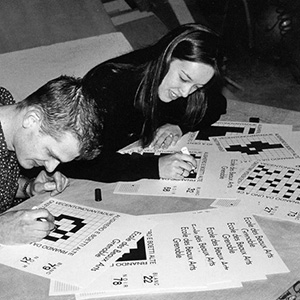
The preparatory work of the kilims, made by Fine Arts students in France
On 26 October, in Paris, his sculpture Self-portrait was installed as a point de mire in the great lobby of the Centre Pompidou, while in Rome AB, working frenetically, completed preparations for the complex exhibition in Grenoble. Fundamental to the success of the project was the extraordinary personal commitment of Adelina von Furstenberg. At the beginning of the catalog she paid a heartfelt tribute to the artist, with a Sufi parable about a khilim. Between the curator and the artist there was not just a close friendship but also a special elective affinity for the culture of central Asia. “Giovanni Battista Boetti was an ancestor of Alighiero Boetti and also a Sufi of the order of the Masters (Khwajagan), founded by the Master Naqshbandi of Bukhara. I came across a story which Naqshbandi used to tell his disciples to illustrate the ‘hidden dimension’, through the quest for knowledge.”
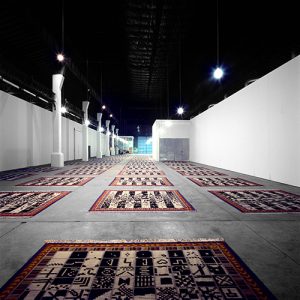
The 50 kilims at the “De bouche à oreille” exhibition at the Magazin de Grenoble, November 1993, photo by Giorgio Colombo
In the same catalog the curator, Angela Vettese, presented a cultured repertory of images, reflecting the many-sidedness of AB’s artistic development and in particular his Pensato e quadrato series: cosmic combinations starting from the Hebrew alphabet, Japanese manuscripts, medieval poems, the incipit of Mozart’s Danse Allemande, the “magic square” studied by Blaise Pascal and the Chinese ideogram for the plenitude of the void.
With great fortitude AB succeeded in being present at the opening ceremony in Grenoble on 27 November.
1994
There were two outstanding exhibitions this year. Though AB was unfortunately unable to be present, he supervised and arranged them.
On 17 February, “Origine et destination, Alighiero e Boetti – Martin Hübler” opened at the Palais des Beaux-Arts in Brussels, curated by Marianne van Leeuw and Annas Pontégnie. The exhibition, a dialog between two founders of international conceptual art, included an interactive work involving the public, using a mechanism for the selection of photocopied images that recalled Boetti’s practice with his “red books.” The artist was unable to attend the event.
In spring Caterina Boetti traveled to Peshawar to collect the large Mappa with the Russian flag corrected after the fall of the Berlin wall.
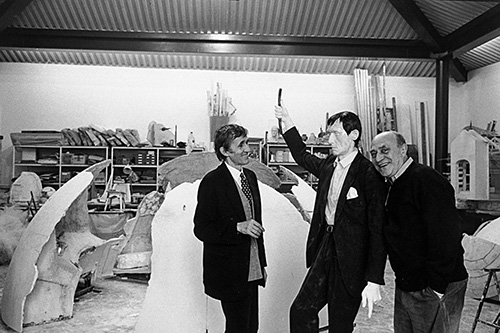
Alighiero Boetti, Arnaldo Pomodoro and Self-Portrait, photo by Carlo Orsi, 1993
On 24 April 1994, AB died in his home on Via del Teatro Pace in Rome.
On 5 May, the Lavoro postale moved from Grenoble to the Musée de la Poste in Paris, with the presentation of the second catalog edited by Angela Vettese.
On 7 August, in Los Angeles, the MOCA Museum repeated the installation of fifty khilim in “Alternating from 1 to 100 and vice versa,” curated by Alma Ruiz and Thierry Ollat (a collaborator of Adelina von Furstenberg). The exhibition then moved to the P.S.1 in New York, where it opened on 9 October.
In New York the autumn was transformed suddenly into a posthumous celebration of AB’s work, presented simultaneously at four exhibitions inaugurated between 4 and 9 October: not only in “Worlds Envisioned,” the joint exhibition with the other “Magicien de la Terre,” Frédéric Bruly-Bouabré, at the DIA Foundation and the solo exhibition at the P.S.1 Museum on Long Island, but also at two prestigious group exhibitions: “Mapping” at the MoMA and “The Italian Metamorphosis” at the Solomon Guggenheim Museum.
In the catalog of “Worlds Envisioned,” among the twelve artists involved, his son Matteo wrote: “A few days before moving to Paradise, Alighiero told me yet again how happy he was to be having this exhibition with Bruly, his African brother… He was fascinated by the comparison with him, so distant geographically, so unique in his relationship with the sacred, with the mystery. Here they were today, more different than even from each other, the black medicine man, alive, and the white medicine man, that shaman-showman, now probably above the Afghan lakes in the country he so much loved. But they had in common a special respect for invention and intelligence, the same generosity in the speech, in action, in revealing beauty and its mechanisms.”


